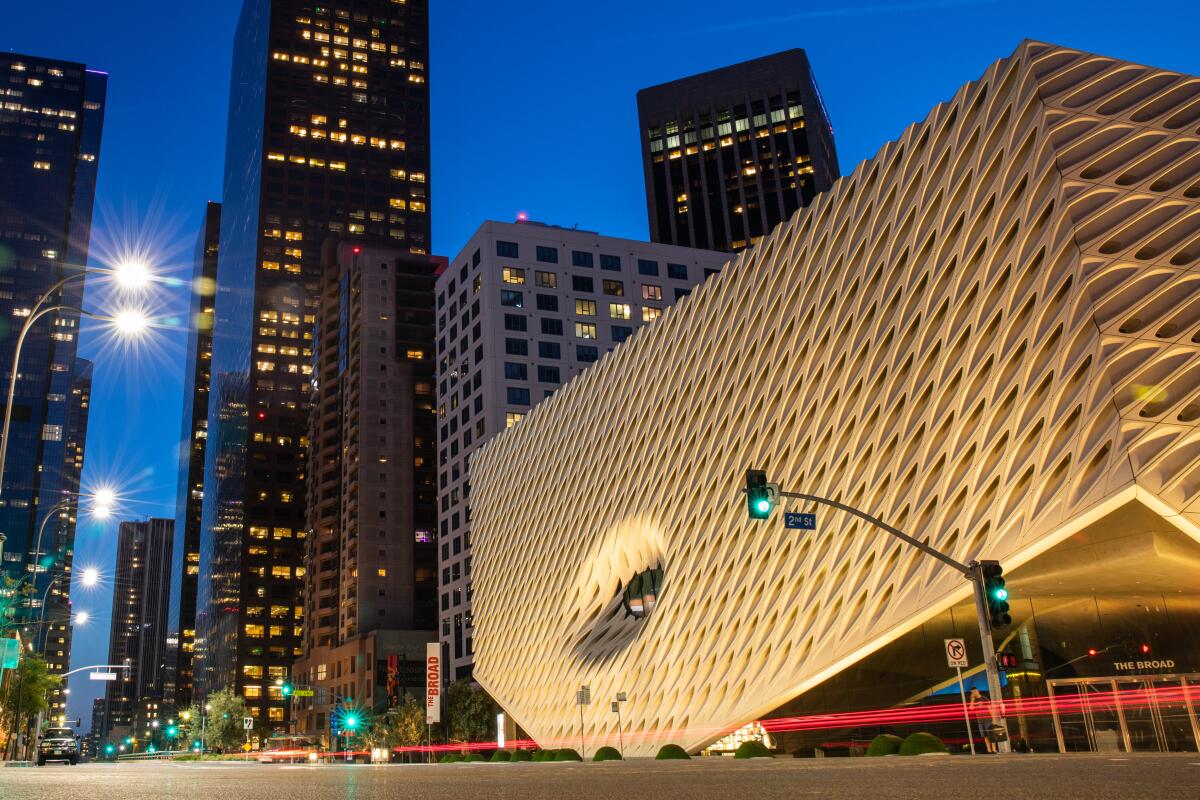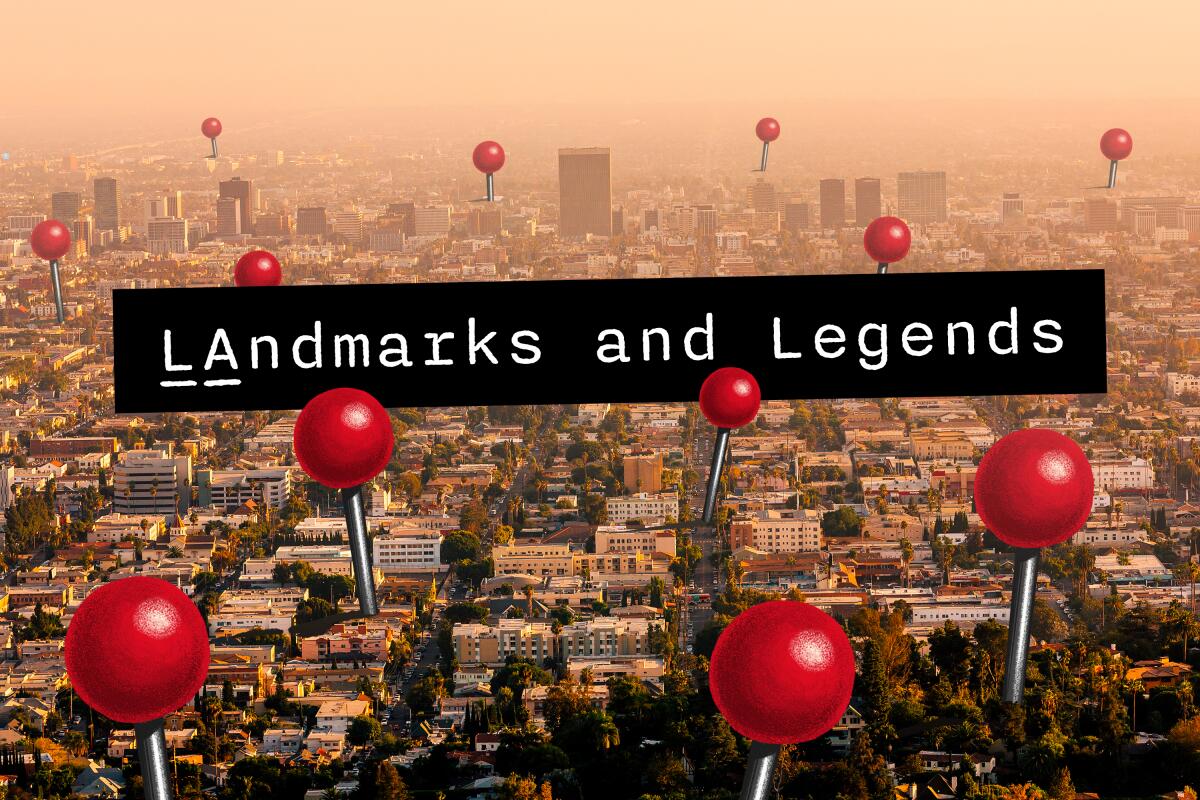
(Jim Cooke / Los Angeles Times; photo via Gettyimages)
The surprising stories behind some of L.A.’s most famous landmark names
- Share via
Surely you’ve seen some name or another blazoned on a local landmark and wondered to yourself, who are those guys? (In many cases, they are guys, yes. But not all!) There’s Griffith Park, named for the fascinating and dastardly Griffith J. Griffith; or Dockweiler Beach, named for the lawyer and politician Isidore Bernard Dockweiler; or the Bradbury Building downtown, named not for science fiction luminary Ray Bradbury but for real estate tycoon Lewis L. Bradbury. And the list goes on (see below).
So here are origin stories of some (but by no means all) of L.A.’s landmarks and legends — the rich, famous, unknown and sometimes infamous names behind L.A.’s most interesting parks, beaches, buildings, mountain peaks and Valley streets.
Showing Places
Bradbury Building
Downtown L.A. Historical Landmark
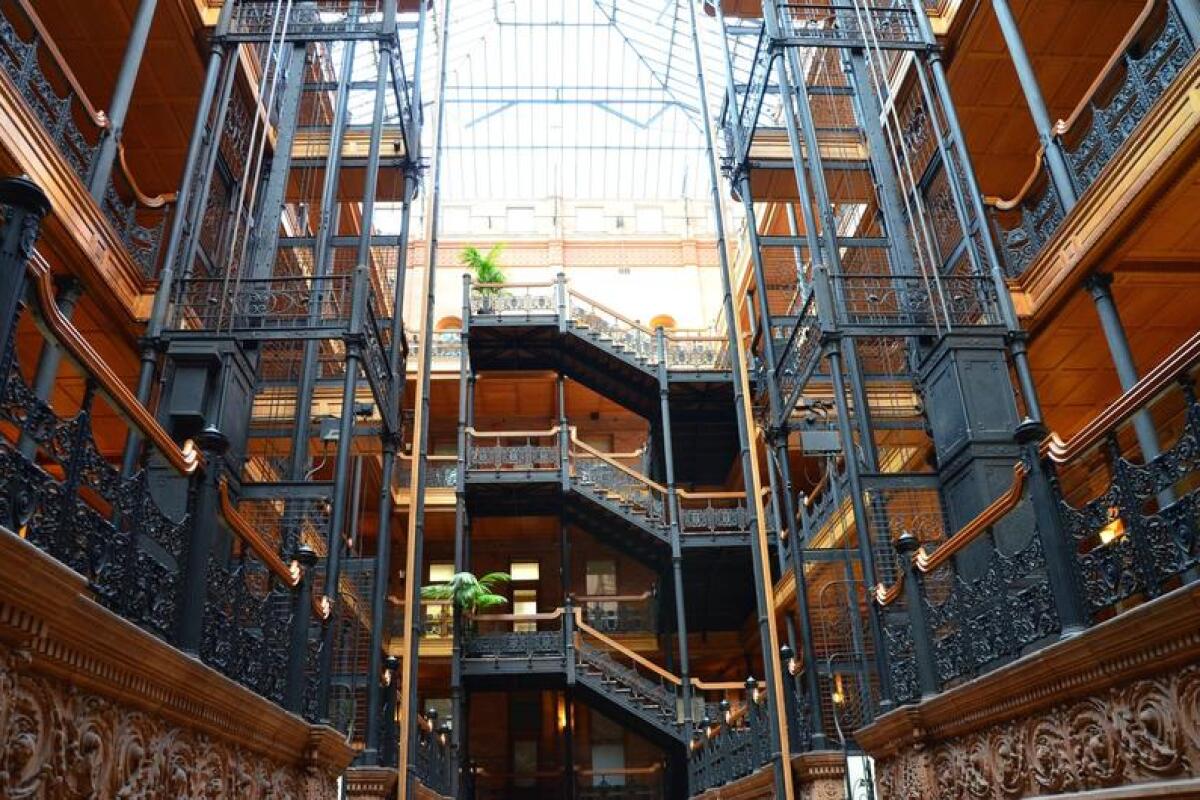
(Christopher Reynolds / Los Angeles Times)
The man who envisioned and paid for this — I’d call it “Victorian futurist” — building was the silver-mine and real estate tycoon Lewis L. Bradbury, whose name adorns a town in the San Gabriel Valley. Bradbury’s wife, Simoneta, finished the building after he died. Opened: 1893.
Read more >>
Read more >>
Route Details
Oviatt Building
Downtown L.A. Historical Landmark
James Oviatt is the man behind this Art Deco masterpiece, home to his high-end haberdashery and a jewel-box penthouse apartment. Today, there’s dinner and dancing in the ground-floor Cicada restaurant and lounge. Opened: 1927.
Read more >>
Read more >>
Route Details
Getty Center
Brentwood Museum

(Genaro Molina / Los Angeles Times)
Two Los Angeles-area museums bear the name of the oilman J. Paul Getty — this hilltop haven for paintings, statuary and photographs, as well as the Getty Villa in Malibu, which was originally built when its namesake ran out of room to keep all his stuff. Opened: 1997.
Read more >>
Read more >>
Route Details
Skirball Cultural Center
Museum
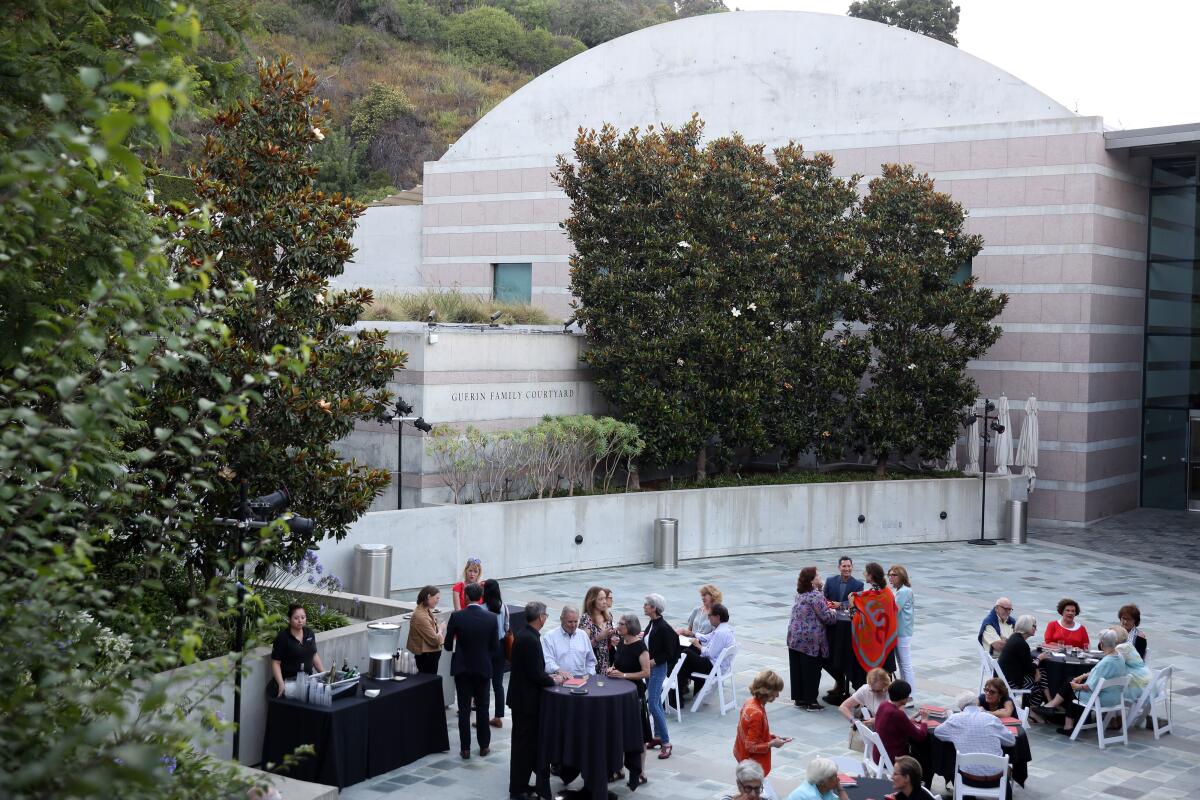
(Dania Maxwell / Los Angeles Times)
Jack H. Skirball may have been the world’s only rabbi/developer/philanthropist. The meeting and exhibit space named after him describes itself as “guided by the Jewish tradition of welcoming the stranger and inspired by the American democratic ideals of freedom and equality.” Founded: 1996
Read more >>
Read more >>
Show more Show less
Route Details
Norton Simon Museum
Pasadena Museum
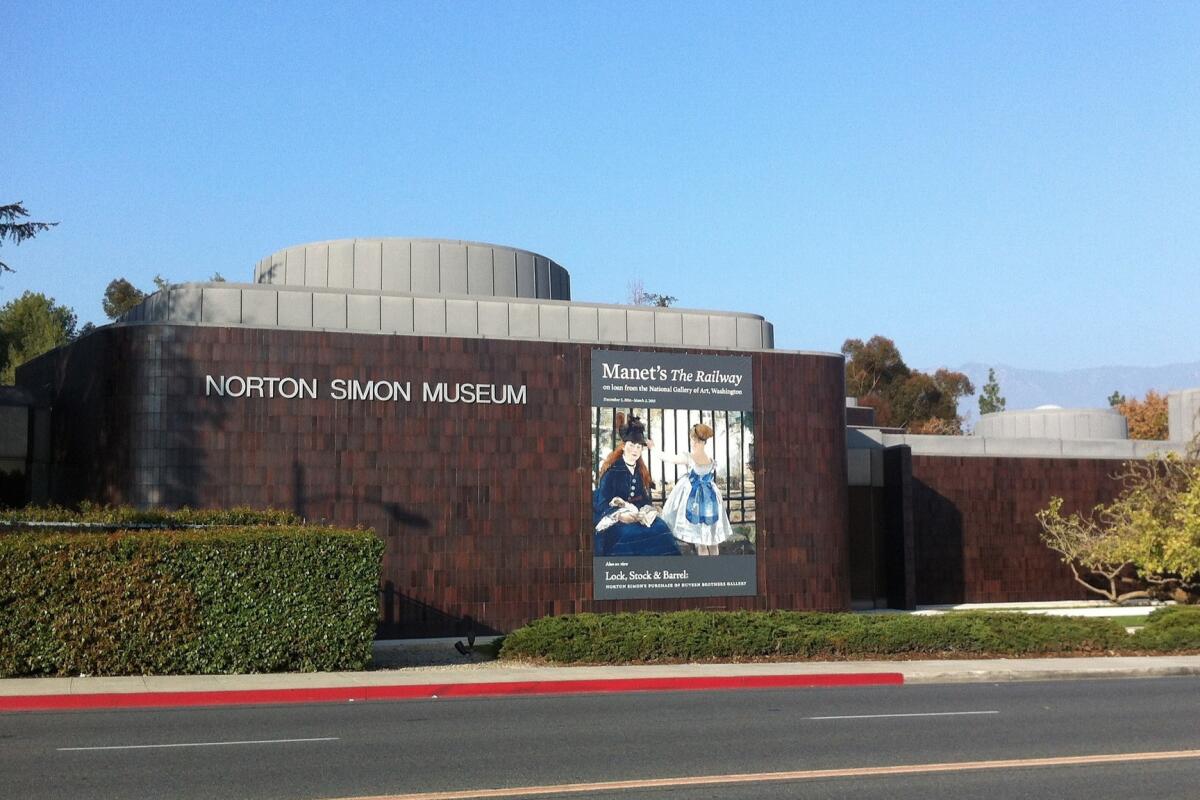
(John Antczak / Associated Press )
Founded as Pasadena’s art museum, it was facing ruin in 1974 when it agreed to Norton Simon taking it over, paying its bills and installing his own enormous and top-notch collection there. Simon was a sharp-elbowed businessman who leveraged railroads and canned tomatoes and other enterprises into a fortune. And he spent a lot of it on Old Masters, Impressionists, Asian treasures — 12,000 works in all. Founded: 1922.
Read more >>
Read more >>
Show more Show less
Route Details
Get cultured at Hammer Museum
Westwood Museum
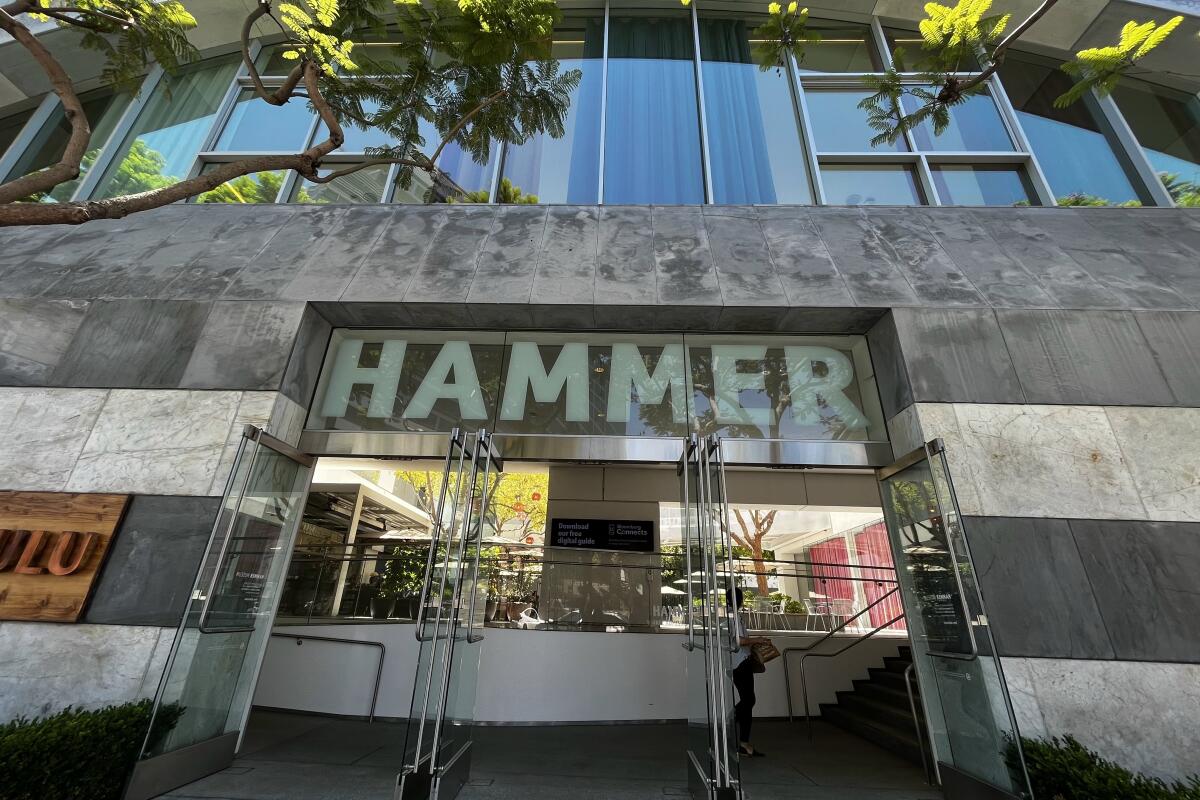
(Nicole Kagan / Los Angeles Times)
Hammer Museum isn’t big. There’s around five exhibitions on view on a typical day. But the avant-garde selection of artworks and unique architecture make it worth the visit.
All walkways in the museum are outdoors, making it almost feel as if each gallery is its own store in a beautiful outdoor mall. Once you finish exploring one collection of art, you can cleanse your palette outside before entering the next space.
After you’re done looking at the art, which shouldn’t take more than an hour, you can relax on some funky furniture on the patio or play a game of ping pong with your friends on colorful tables. There’s also an outdoor cafe on the main floor where you can order a gourmet snack or sandwich.
Entry to the museum is free with valet parking for $10 and limited nearby street parking. Stopping by the gift shop on your way out is a must. It’s not cheap, but even if you don’t buy anything, you can still smell the candles, flip through the books and play with the gadgets.
All walkways in the museum are outdoors, making it almost feel as if each gallery is its own store in a beautiful outdoor mall. Once you finish exploring one collection of art, you can cleanse your palette outside before entering the next space.
After you’re done looking at the art, which shouldn’t take more than an hour, you can relax on some funky furniture on the patio or play a game of ping pong with your friends on colorful tables. There’s also an outdoor cafe on the main floor where you can order a gourmet snack or sandwich.
Entry to the museum is free with valet parking for $10 and limited nearby street parking. Stopping by the gift shop on your way out is a must. It’s not cheap, but even if you don’t buy anything, you can still smell the candles, flip through the books and play with the gadgets.
Show more Show less
Route Details
The Huntington Library, Art Museum and Botanical Gardens
San Marino Museum

(Kent Nishimura / Los Angeles Times)
It’s a legendary name from California history, but it was not the uncle, Gold Rush tycoon Collis P. Huntington, who founded the place, but his nephew Henry, who made his fortune in L.A. real estate and married his uncle’s 63-year-old widow, Arabella. Founded: 1919
Read more >>
Read more >>
Route Details
Chateau Marmont
Hollywood Hills West Hotel
The lounge-around hangout of the beautiful people — and anyone else who can afford the price of a room, or at least a cocktail — is named for the street it sits on, Marmont Lane. But where did “Marmont” come from? Most likely from a virtually forgotten silent-film leading man, the English-born Percy Marmont. In dozens of films and on the stage, he played the stoically romantic hero whose characters were usually Lord or Sir or Colonel something. Opened: 1929
Read more >>
Read more >>
Show more Show less
Route Details
Margaret Herrick Library
Library
This research resource entirely about movies — with many thousands of papers: production notes and screenplays, clippings, promotional materials, photographs, musical scores — is named for an Academy of Motion Picture Arts and Sciences librarian and executive director, Margaret Herrick. It is Herrick who in all likelihood gave the saucy name “Oscar” to the academy’s award of merit. Established: 1928
Read more >>
Read more >>
Show more Show less
Route Details
Simon Wiesenthal Center
Other
With its companion Museum of Tolerance, the institution supports Holocaust research and campaigns for human rights for Jews the world over. It’s named for Simon Wiesenthal, the legendary Holocaust survivor and investigator whose work brought some 1,000 Nazi war criminals to justice. Established: 1977
Read more >>
Read more >>
Show more Show less
Route Details
A.C. Bilbrew Library
Willowbrook Library
The South L.A. civic leader Madame A.C. Bilbrew was said to be the first African American to have her own radio show. Her name appears with some frequency in The Times’ stories from the 1920s to the 1950s, like one in 1957 noting her “new show” on radio station KPOP. Opened: 1974
Read more >>
Read more >>
Route Details
Alma Reaves Woods-Watts Branch Library
Watts Library
Alma Reaves Woods, the woman locals knew as “the lady who built the library,” worked for decades to build a library in Watts, buying cheap books and handing them out to kids, lugging books from a faraway library to a housing project where she had once lived, and campaigning door to door for a bond issue to build the branch library that now bears her name. Current building opened: 1996
Read more >>
Read more >>
Show more Show less
Route Details
Masao W. Satow Library
Alondra Park Library
L.A. County Supervisor Kenneth Hahn presided over the library’s dedication in 1977, calling Masao W. Satow “one of America’s most distinguished civic leaders.” In the weeks after Pearl Harbor, Satow addressed a Lawyers Club audience on the topic “We too are Americans.” In February 1942 — before he and his wife were sent off to a relocation camp in Colorado — he presented to county supervisors a parchment with the signatures of hundreds of Japanese Americans pledging “absolute allegiance” to the U.S. He organized YMCA groups in his detention camp and in 1946 came back to California to head the Japanese American Citizens League and, later, to serve on the state’s advisory committee on civil rights.
Read more >>
Read more >>
Show more Show less
Route Details
Ávila Adobe
Downtown L.A. Historical Landmark
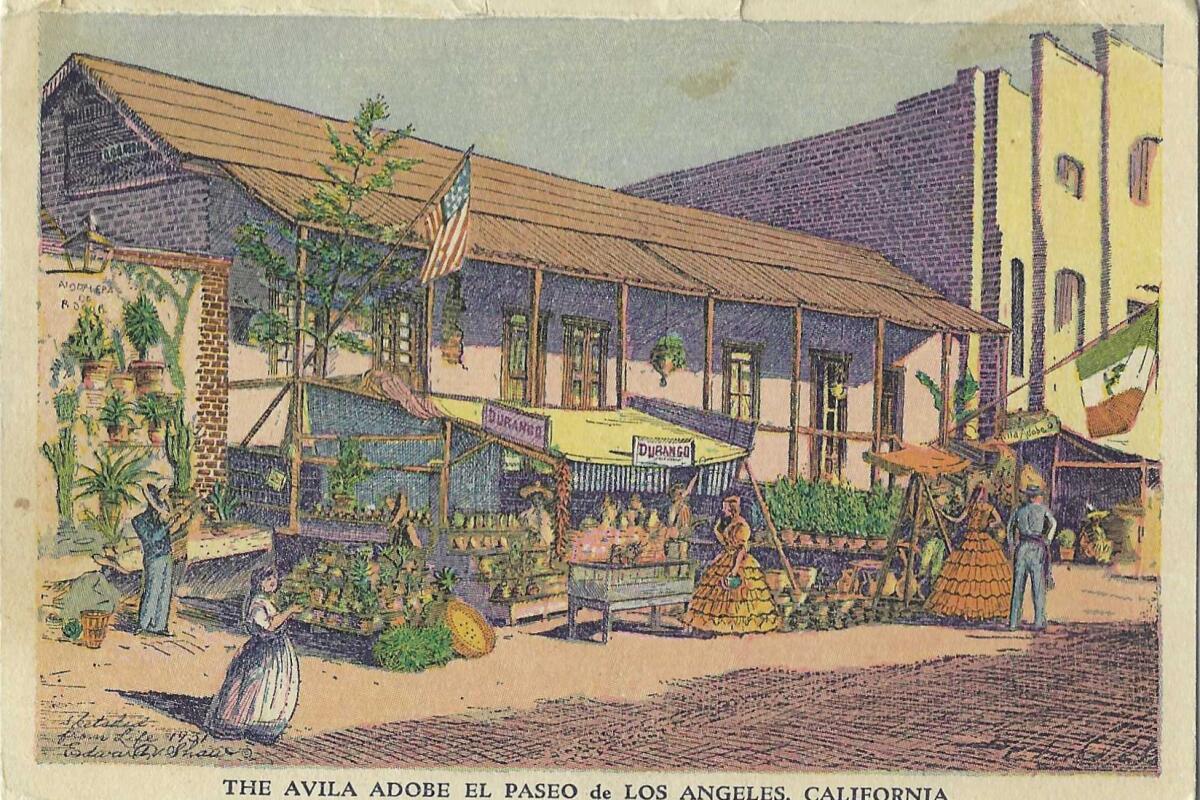
(Courtesy of Patt Morrison)
At 204 years old, it’s the oldest house left standing in the city of L.A. — imagine the built-up equity! Its builder and first resident was the rich pioneer rancher Francisco José Ávila, the city’s mayor in 1810. For nine days in January 1847, Commodore Robert Stockton took over the building as his headquarters in the Mexican-American War, joined by the fabled scout Kit Carson. The Ávila family moved out in 1869, and the place slipped into desultory habitation. It was almost lost twice: when the city condemned it in the 1920s, and the “mother” of the re-created Olvera Street, Christine Sterling, undertook to save it; and again in the 1971 Sylmar earthquake. The adobe was restored as an example of L.A. life in the 1840s.
It isn’t L.A. County’s oldest residence, though. The Gage Mansion, built in 1795 by the Lugo family and named for a California governor who later lived there, is now owned and encircled by a mobile home park in Bell Gardens.
Open for tours 9 a.m. to 4 p.m. daily.
It isn’t L.A. County’s oldest residence, though. The Gage Mansion, built in 1795 by the Lugo family and named for a California governor who later lived there, is now owned and encircled by a mobile home park in Bell Gardens.
Open for tours 9 a.m. to 4 p.m. daily.
Show more Show less
Route Details
Gamble House
Pasadena Historical Landmark
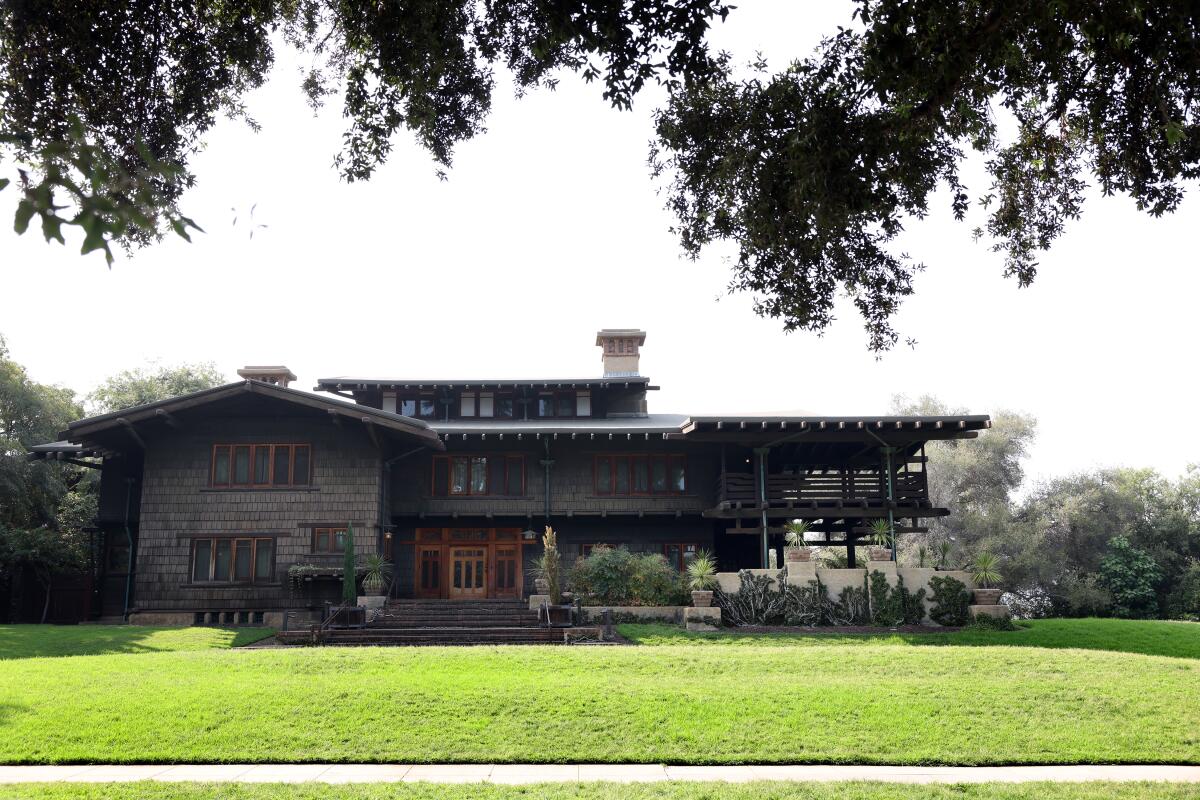
(Dania Maxwell / Los Angeles Times)
This is the flagship of Craftsman houses, built in 1909 by the Greene and Greene architectural firm for the Gamble family, of the Procter & Gamble fortune. The Gamble family heirs gave it to Pasadena in 1966; 11 years later, it was declared a national historic landmark. Built: 1909
Read more >>
Read more >>
Route Details
Grauman’s Chinese Theatre
Hollywood Movie Theater
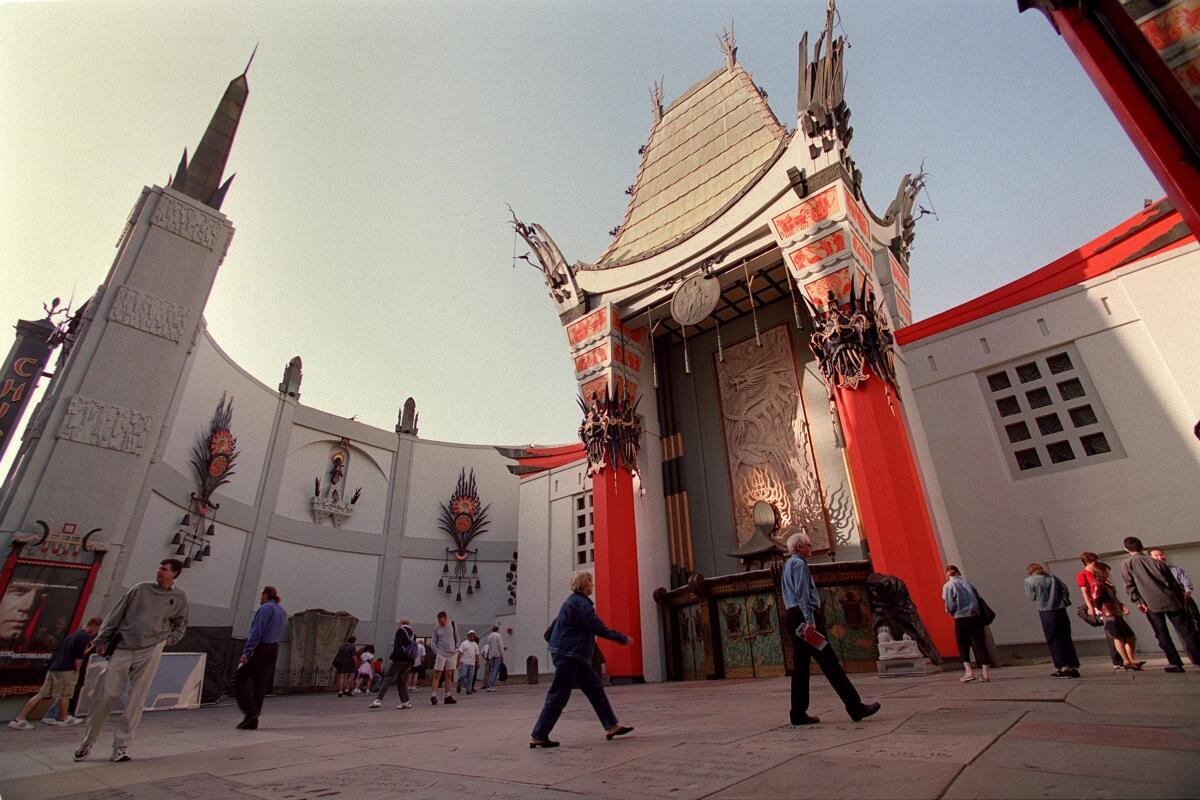
(Perry C. Riddle / Los Angeles Times)
Showman Sid Grauman’s over-the-top theater opened in May 1927 with the premiere of Cecil B. DeMille’s epic “The King of Kings.” Its equally famous forecourt is paved with cement squares into which stars have embedded handprints, footprints and signatures. The theater was sold in 1973 to the Mann chain, which tried without great success to get Angelenos to start calling it “Mann’s Chinese Theatre.” Ditto the Chinese company that bought naming rights in 2013 and rechristened it “TCL Chinese Theatre.” Opened: 1927
Read more >>
Read more >>
Show more Show less
Route Details
Griffith Park
Park
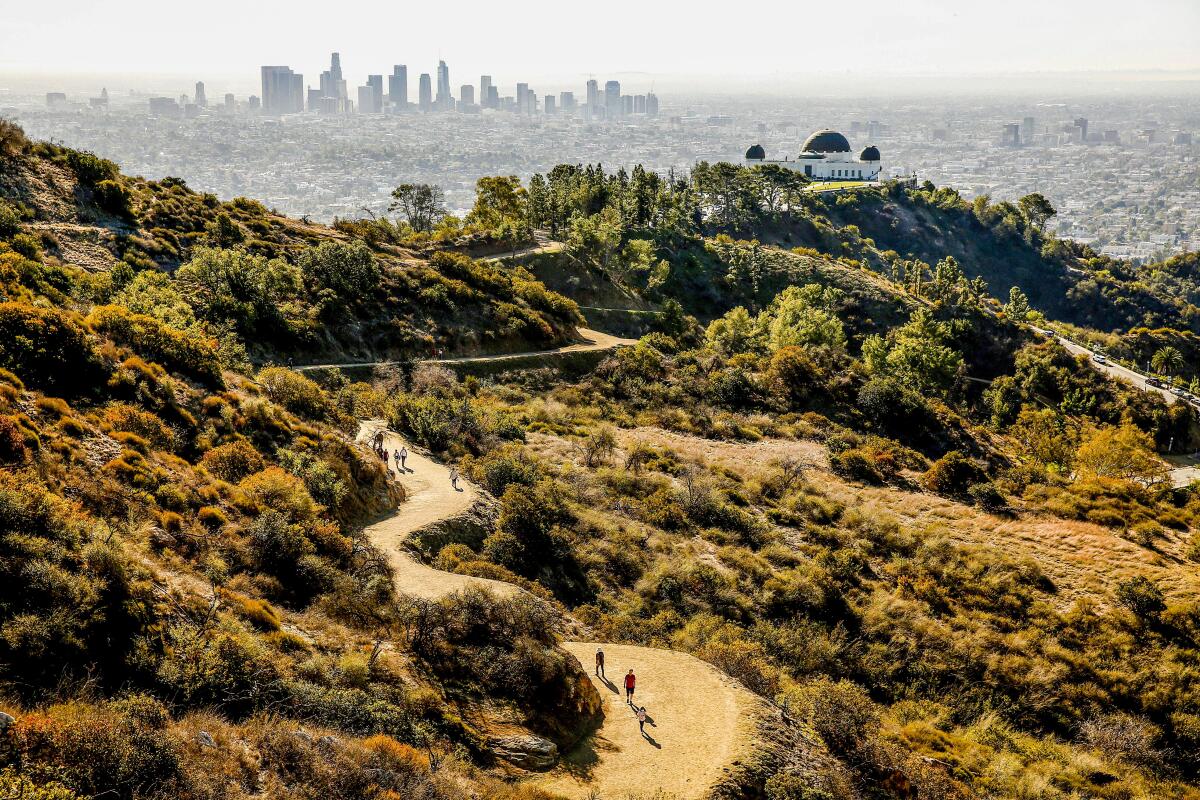
(Al Seib / Los Angeles Times)
It was not, as some believe, named for D.W. Griffith, the silent-film director. No. It was named for the man who gave it to L.A., the Welsh immigrant and mining magnate Col. Griffith Jenkins Griffith. Griffith was one of those self-mythologizing frontier characters, a self-promoter of choleric temper and roller-coaster fortunes. At Christmas 1896 he presented the city with thousands of acres around what we now call Los Feliz. But in 1903, Griffith badly blotted his copybook when he shot his wife in a fury of what the sentencing judge would call “revolting, gross, unmanly and degrading” behavior.
Once he was out of prison, Griffith sought to buy his way back into civic favor with the gift of money to build a planetarium and theater. The city balked. Not until Griffith’s will made the gift posthumously was it accepted.
More about Griffith Park >>
Once he was out of prison, Griffith sought to buy his way back into civic favor with the gift of money to build a planetarium and theater. The city balked. Not until Griffith’s will made the gift posthumously was it accepted.
More about Griffith Park >>
Show more Show less
Route Details
Ernest E. Debs Regional Park
Montecito Heights Park
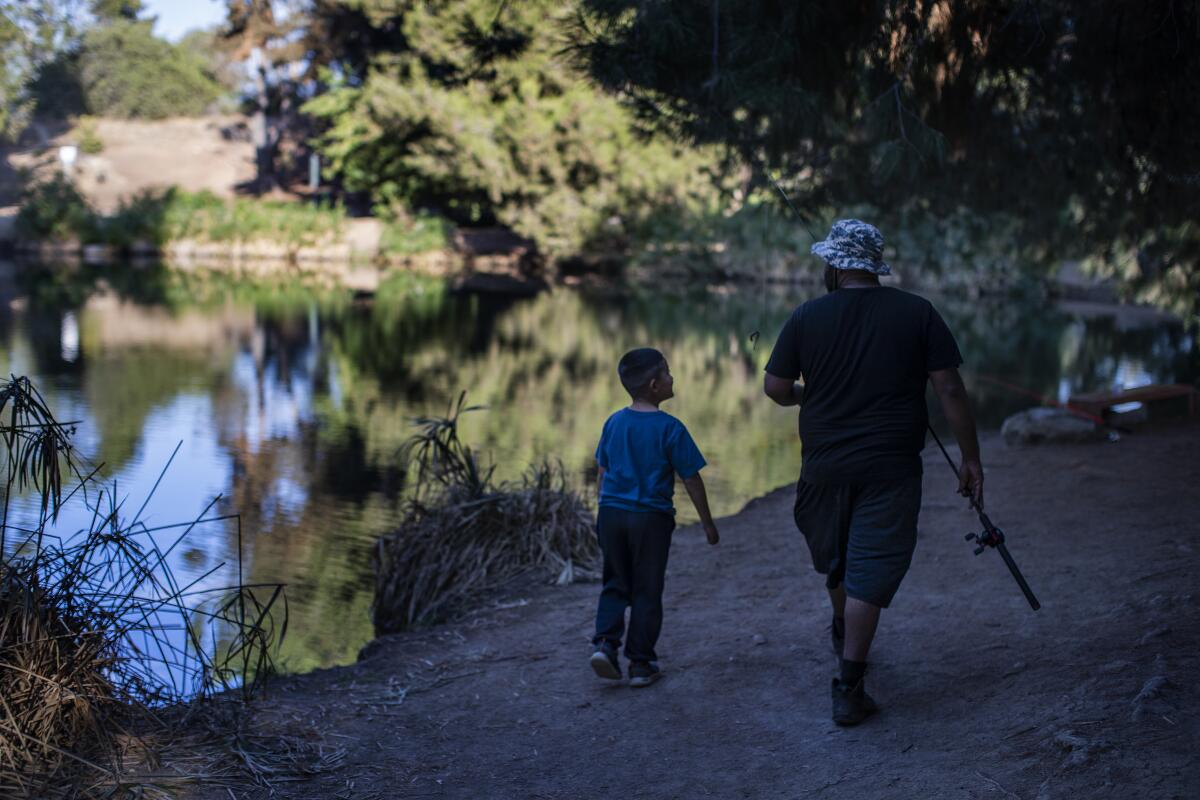
(Gina Ferazzi / Los Angeles Times)
Los Angeles acquired the land in a complex series of deals that involved the feds and land swaps for what would become Dodger Stadium. The neighbors, led by a former Sierra Club president called Nathan Clark, kept developers at bay, and by the late 1960s, county Supervisor Ernest E. Debs managed to get the land dedicated for a county park. In 1974, as he retired, his colleagues voted unanimously to name the park for him.
More about Debs Park >>
More about Debs Park >>
Show more Show less
Route Details
Runyon Canyon Park
Park

(Al Seib / Los Angeles Times)
The precise geography is hazy, but in the 1860s, the government deeded about 160 acres, likely including Runyon Canyon, to the man known to history as “Greek George.” His is a long story, but the canyon was bought in 1919 by coal millionaire Carman Runyon. An Irish tenor named John McCormack bought the land in 1929. When McCormack was on tour, his estate became a high-end place to stay for movie folk. In later years, Errol Flynn moved into the estate’s poolhouse at the invitation of his host and the next owner, Huntington Hartford, heir to grocery store millions.
In the 1960s, Hartford offered the land as a flat-out gift to the city, but for some reason, Mayor Sam Yorty turned him down. In 1984, the city was finally able to buy the land. Somehow, of all of the landowners, it was the name “Runyon” that stuck.
More about Runyon Canyon >>
In the 1960s, Hartford offered the land as a flat-out gift to the city, but for some reason, Mayor Sam Yorty turned him down. In 1984, the city was finally able to buy the land. Somehow, of all of the landowners, it was the name “Runyon” that stuck.
More about Runyon Canyon >>
Show more Show less
Route Details
Jack Dunster Marine Biological Reserve
Long Beach Park
The Jack Dunster Marine Biological Reserve honors the work of the local man who cobbled together a working expertise in engineering technology and marine life to create a flourishing ecosystem on the Los Cerritos Channel.
Route Details
Vasquez Rocks Natural Area and Nature Center
Agua Dulce Park
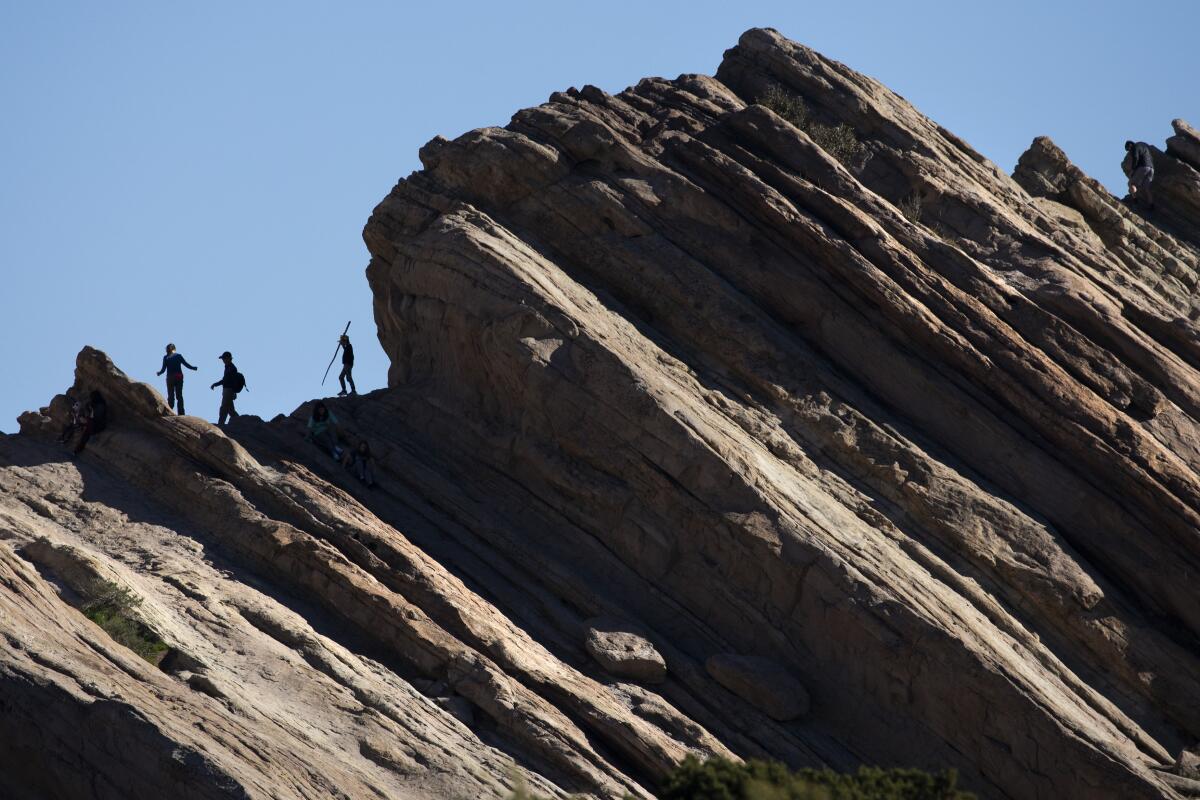
(Myung J. Chun / Los Angeles Times)
Tiburcio Vasquez was the swashbuckling bandit chief who defended his crimes as a simple justice for his people against the Yankee invaders. The spectacular Vasquez Rocks — hundreds of acres with fabled, other-worldly sandstone formations in Agua Dulce — were his onetime hideout.
More about Vasquez Rocks >>
More about Vasquez Rocks >>
Show more Show less
Route Details
Maggie Hathaway Golf Course
Gramercy Park Golf Course
In one of her life’s incarnations, Hathaway was a stand-in for Lena Horne in “Stormy Weather.” But her name is on the golf course because she held the very white game of golf to account.
She took her first swing at a golf ball in 1955 on the Griffith Park course, where she had gone to give Black boxing champ Joe Louis a piece of her mind for playing in a pro-am tournament when “truly excellent Black golfers” were barred from pro golf. She found him on the eighth hole, and as he hit the ball onto the green, she scoffed, “Anybody could do that.” Louis bet Hathaway a set of golf clubs that she couldn’t. She did — her first-ever golf swing — and battled for Black golfing ever after.
More about Maggie Hathaway >>
She took her first swing at a golf ball in 1955 on the Griffith Park course, where she had gone to give Black boxing champ Joe Louis a piece of her mind for playing in a pro-am tournament when “truly excellent Black golfers” were barred from pro golf. She found him on the eighth hole, and as he hit the ball onto the green, she scoffed, “Anybody could do that.” Louis bet Hathaway a set of golf clubs that she couldn’t. She did — her first-ever golf swing — and battled for Black golfing ever after.
More about Maggie Hathaway >>
Show more Show less
Route Details
Eugene A. Obregón Park
East Los Angeles Park
The name of a teenaged war hero from East L.A. appears on several memorials around L.A., and on a park close to home. Marine PFC Eugene A. Obregón was awarded the Medal of Honor posthumously for his actions in Seoul, Korea, in September 1950.
More about Eugene Obregón >>
More about Eugene Obregón >>
Route Details
Travel back in time at the Virginia Robinson Gardens
Beverly Hills Park
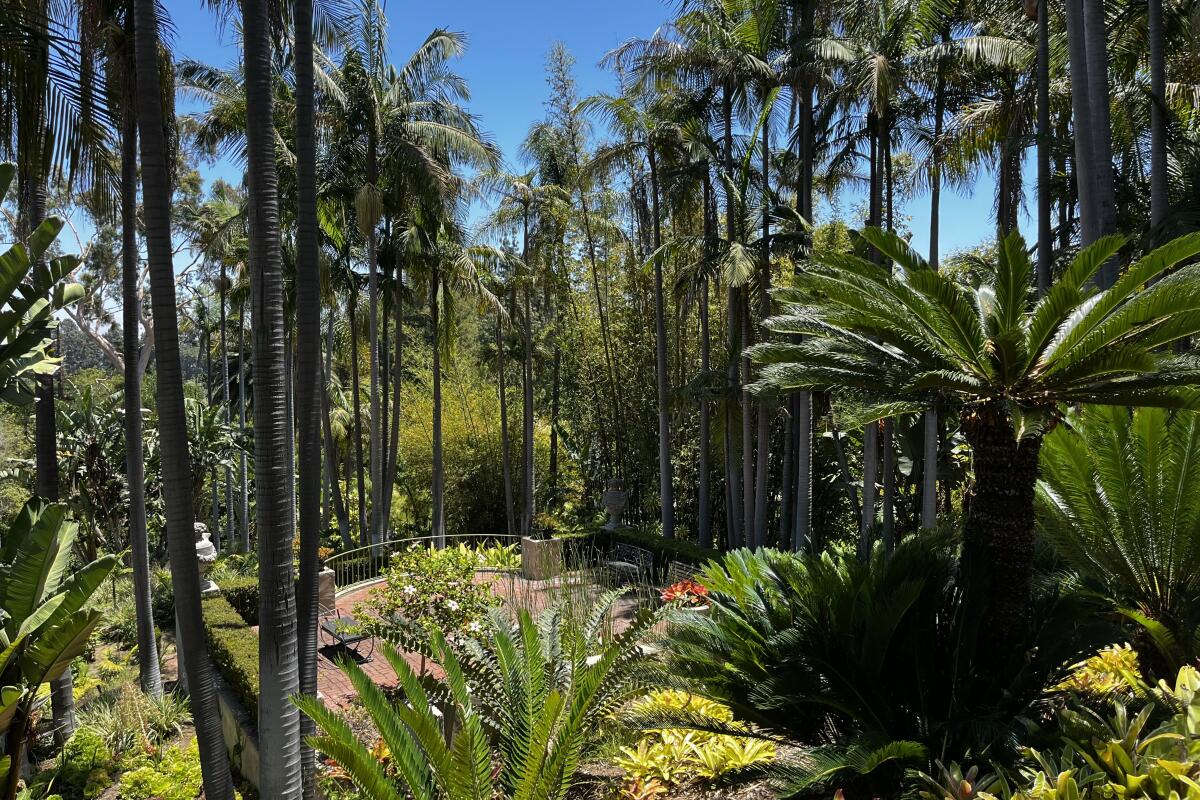
(Nicole Kagan / Los Angeles Times)
From the outside, the Virginia Robinson estate appears no different than the rest of the homes on its quiet residential road. Beyond the gates though, it is a sprawling oasis complete with themed gardens, pools and an orchid house.
Nature-lovers and history buffs alike are free to geek out on this 6.2-acre property. Not only is it picturesque, but it is also a historical landmark: it was the first luxury estate built in Beverly Hills. A 90-minute guided tour will take you through the mansion and the various gardens including the kitchen garden and the king palm forest.
The property is only available to view by a guided tour, which costs $15 (with discounts for children, students and seniors) and must be reserved in advance. There is free parking on site.
Nature-lovers and history buffs alike are free to geek out on this 6.2-acre property. Not only is it picturesque, but it is also a historical landmark: it was the first luxury estate built in Beverly Hills. A 90-minute guided tour will take you through the mansion and the various gardens including the kitchen garden and the king palm forest.
The property is only available to view by a guided tour, which costs $15 (with discounts for children, students and seniors) and must be reserved in advance. There is free parking on site.
Show more Show less
Route Details
Pershing Square
Downtown L.A. Park
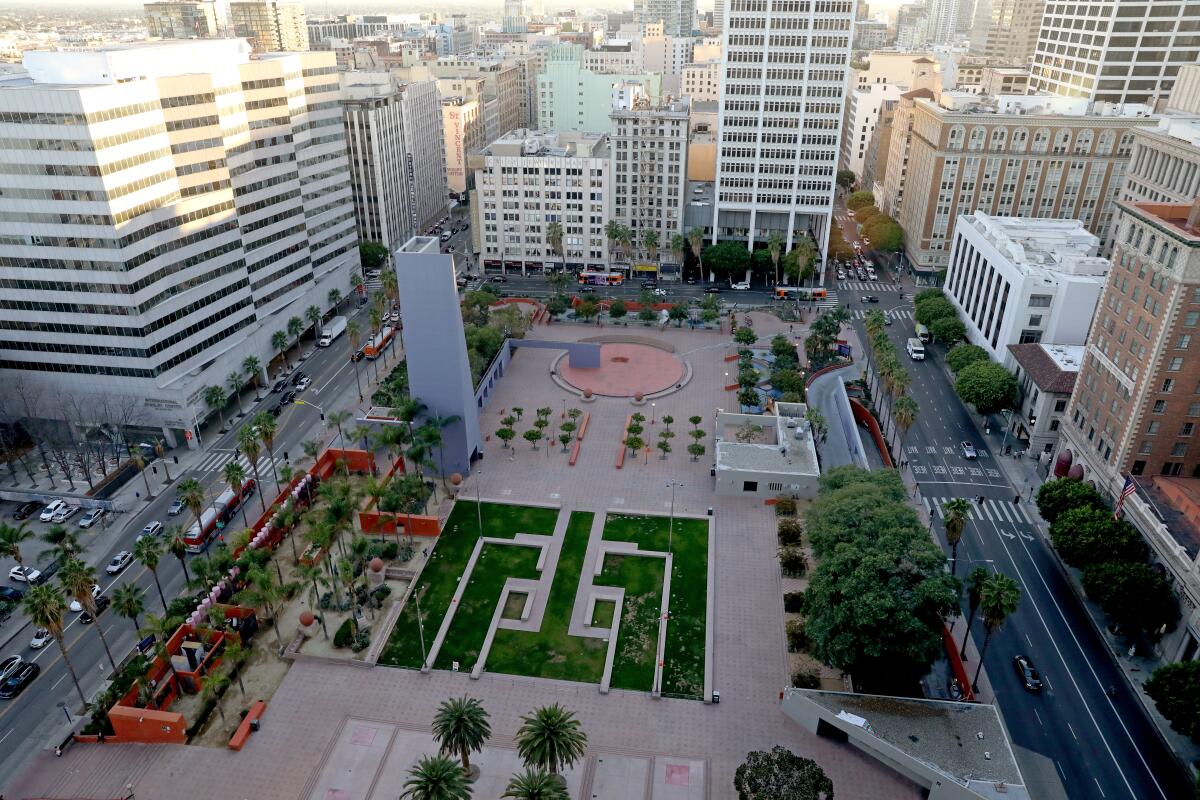
(Gary Coronado / Los Angeles Times)
“Pershing” is General John J. “Black Jack” Pershing, who pursued Pancho Villa’s forces along the U.S.-Mexico border a few years before going on to the “big show,” World War I. He led the American Expeditionary Forces on Europe’s Western Front in 1917 and 1918. In a patriotic mood, the city renamed the park for him in November 1918, one week after the armistice ended the war.
More about Pershing Square >>
More about Pershing Square >>
Show more Show less
Route Details
Bette Davis Picnic Area
Park
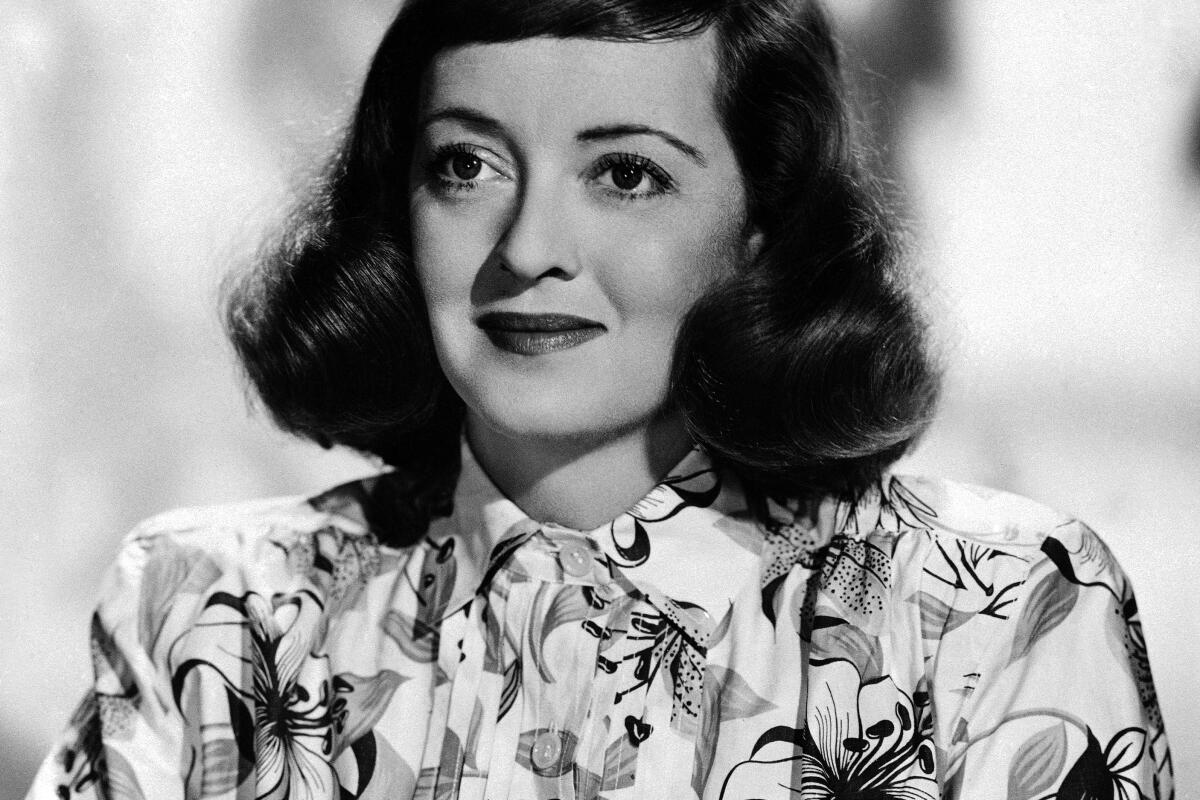
(Associated Press)
Yes, Bette Davis worked nearby, at Warner Brothers; yes, she lived not far away and rode her horse along the bridle paths; and yes, she’s buried up the hill in Forest Lawn. But the dissonance of “Bette Davis” and “picnic”? A more urban actress I can’t conjure.
More about Bette Davis Picnic Area >>
More about Bette Davis Picnic Area >>
Route Details
Brand Boulevard
Glendale Street

Brand Boulevard in Glendale is named for promoter and philanthropist Leslie C. Brand.
Glendale’s Brand Boulevard could be no other than Leslie C. Brand, the 5-foot-tall landowner, promoter and philanthropist who quite truly put Glendale on the map.
Route Details
Edward Everett Horton Lane
Encino Street
The very abbreviated Edward Everett Horton Lane abutting the Ventura Freeway in Encino was named for the comic character actor who bought his Valley acres in 1925.
Route Details
Sepulveda Boulevard
Sherman Oaks Street
The longest street in L.A. County is Sepulveda Boulevard, 40 miles from Mission Hills to Long Beach, named for Francisco Xavier Sepulveda, the propertied pioneer rancher and paterfamilias to the influential founding family.
More about Sepulveda and the ranchos >>
More about Sepulveda and the ranchos >>
Route Details
Sherman Way
Van Nuys Street
Moses H. Sherman was one of those digit-in-every-dealing businessmen: law, mining, water, railways, and real estate. Sherman Way is named him, not for the Civil War General William Tecumseh Sherman. (Sherman also double-dipped: Hazeltine, his middle name and the name of his daughter, is also up there on a street sign.)
Show more Show less
Route Details
Lankershim Boulevard
Universal City Street
If you have reason to hate the 405 Freeway, put it down to Isaac Lankershim, who made a wagon road through the pass to get his wheat to export ships, and then, when the railroad came to the Valley, converted his wagon path into a toll road. Lankershim was a Bavarian-born farmer who came south from Sacramento and joined up with other Jewish immigrants to buy scores of square miles across the southern stretch of the Valley from Pio Pico, the last governor of Mexican California.
Show more Show less
Route Details
Van Nuys Boulevard
Van Nuys Street
As a two-fer Valley pair, Isaac Lankershim was the elder, and his son-in-law, Isaac Newton Van Nuys, the junior. They had the same first name, as well as an eagerness to own and cultivate a whole lot of land, and they turned tens of thousands of acres first to sheep ranching and then to growing wheat and barley that was sold around the world. The son-in-law gets the bonus of a neighborhood with his name on it.
Show more Show less
Route Details
Otis Avenue
Tarzana Street
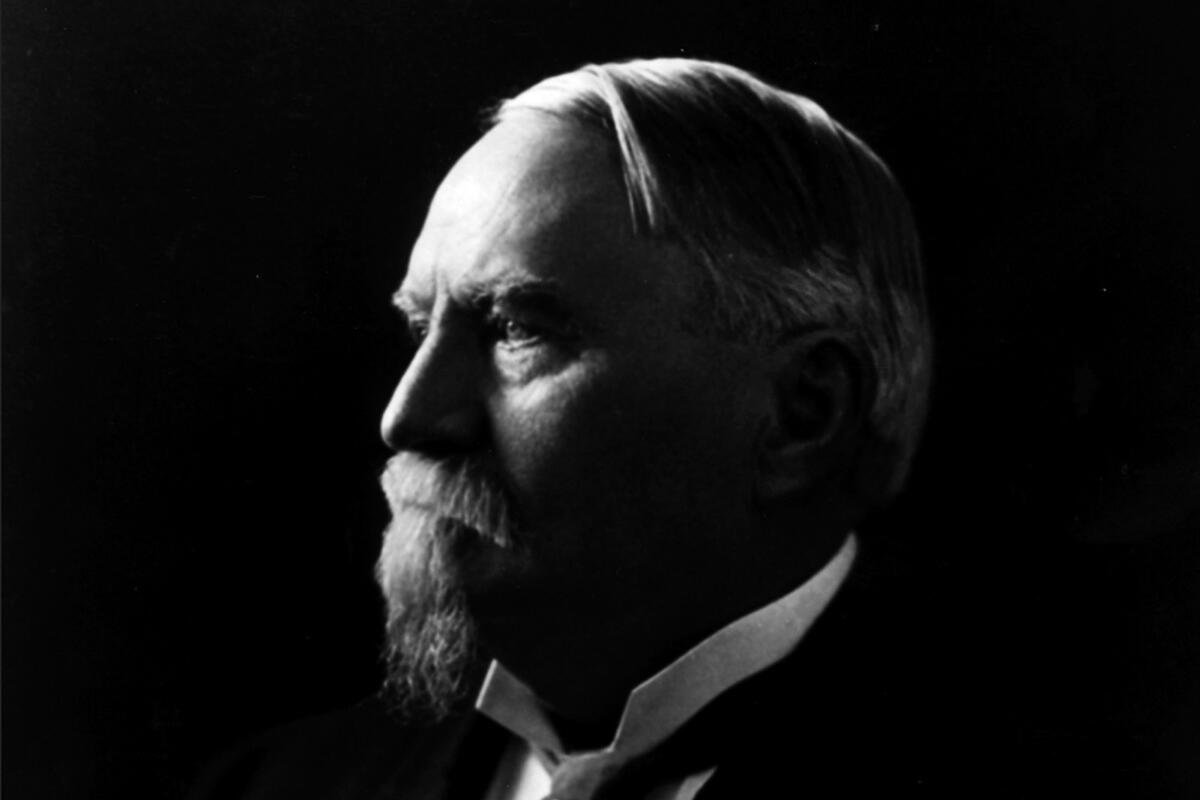
Harrison Gray Otis, The Times’ owner-publisher, was a master operator who licked his chops when he laid eyes on Southern California, “the fattest place I ever was in.” He owned tracts in the Valley and helped to engineer the aqueduct taking Owens Valley water to make those tracts even more valuable. His name remains on Otis Avenue.
Show more Show less
Route Details
Chandler Boulevard
Street
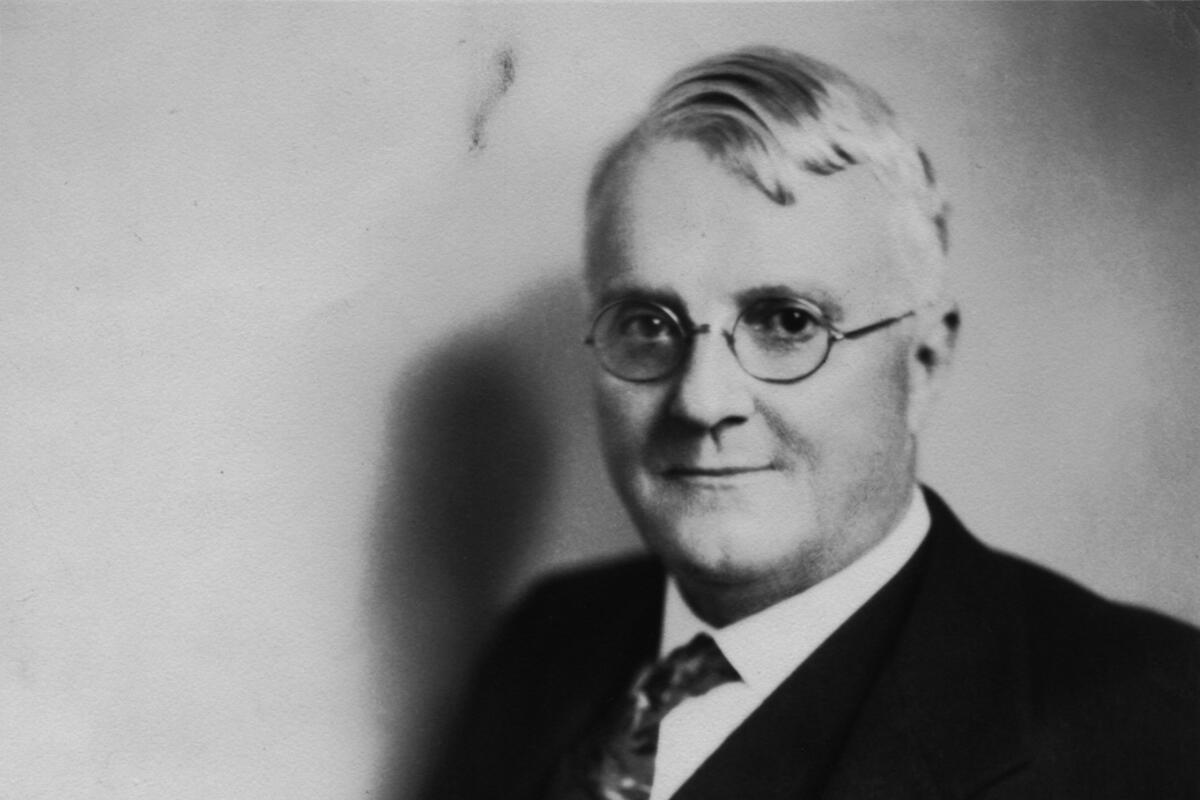
(Photographer unknown. From the Los Angeles Times History Center)
Harrison Gray Otis’ son-in-law was the savvy Harry Chandler, of Chandler Boulevard, who succeeded his father-in-law and, if anything, thought even bigger, joining a syndicate that bought up almost 75 square miles of Valley land, and naming the group for exactly what the Valley became: the Los Angeles Suburban Homes Company.
Show more Show less
Route Details
De Celis Place
Van Nuys Street
The Valley’s enormous northern half belonged to the de Celis family. The lands of the San Fernando Mission had gone up for grabs when the missions were secularized. Pico kept it in friendly hands when he sold it to the de Celises right before the treaty of Cahuenga made California an American possession. De Celis Place parallels Hayvenhurst Avenue north of the Sepulveda Basin. The de Celises were hard up when they sold their property in the 1870s to a man named Charles Maclay. (Maclay has his own street — not a boulevard or avenue, though — not far from the county’s San Fernando courthouse.)
Show more Show less
Route Details
Topanga Canyon Boulevard
Canoga Park Street

Topanga Canyon Road descends into the San Fernando Valley on a vintage postcard from Patt Morrison’s collection.
Topanga comes from the Tongvan word “Topaa’nga,” but the English meaning is unclear. It’s the name of the enchanting canyon and the road that runs through it, which is on the books as State Route 27, from the Pacific Ocean in Malibu to the Ronald Reagan Freeway in Chatsworth. I can’t think of anyone who would call it State Route 27, except maybe the bossy recorded voice on your GPS.
Show more Show less
Route Details
Tujunga Avenue
North Hollywood Street
Tujunga is a tidy avenue from Universal City to Sun Valley, its name altered from the Tongvan language “tuhuunga,” meaning “place of the old woman.” This was per UCLA’s emeritus linguistics prof and Native American languages whiz Pamela Munro. A Times story of three decades ago says the word was thought to mean “big thunder” in the Tataviam language of a tribe of Valley Native Americans.
Show more Show less
Route Details
Canoga Avenue
Canoga Park Street
“Canoga,” according to a 1905 place-name explainer from the U.S. Geological Survey, is very likely a Native American name — but not a California one. Its origin is probably the Cayuga people and the onetime Iroquois village of “Ganogeh” near the Finger Lakes of New York.
Route Details
Mulholland Drive
Street
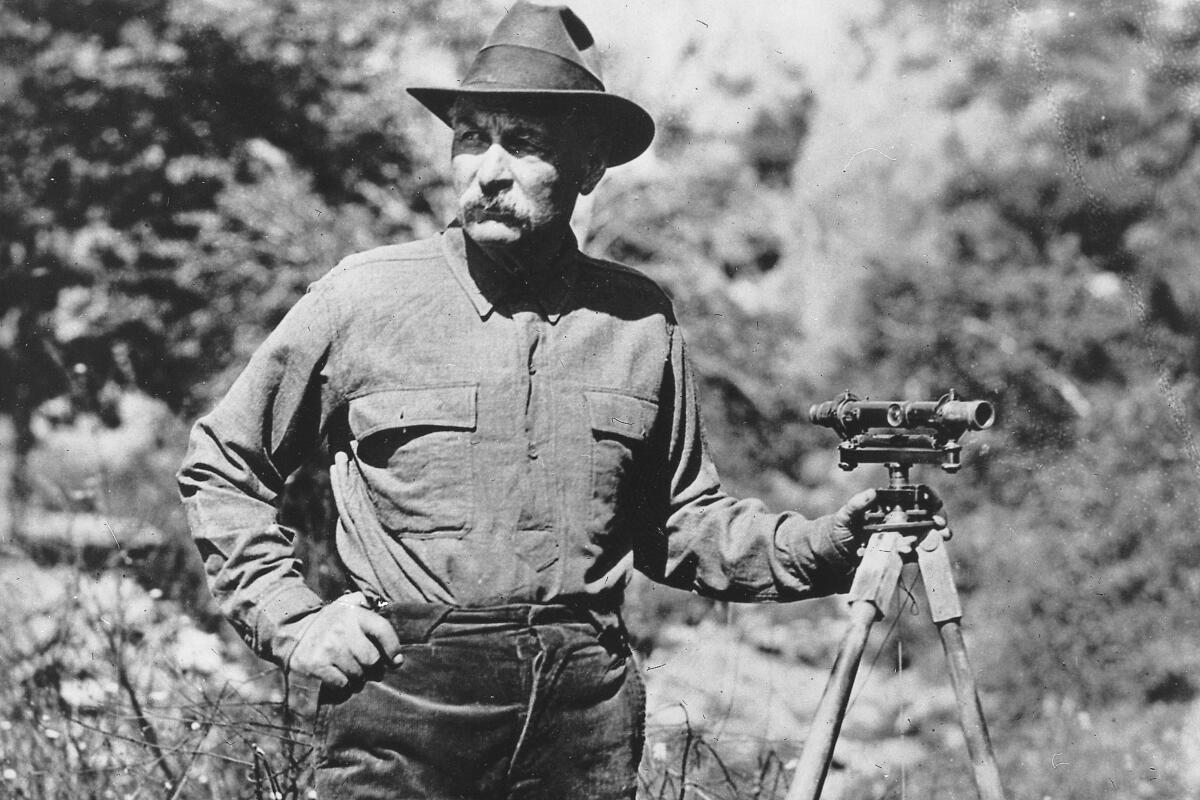
(Courtesy of University of Southern California Libraries / California Historical Society)
Its name is owed to William Mulholland, who changed the character of the Valley and of L.A. with the immense water project that stuck an engineered siphon into a lake 233 miles away and brought its water south to the city of thirsting angels.
Route Details
Cabrillo Beach
San Pedro Beach

(Carolyn Cole / Los Angeles Times)
Cabrillo Beach in the harbor neighborhood of San Pedro is named for Juan Rodriguez Cabrillo, the first European to visit California, 480 years ago, and where he also took up eternal residence after he died on Catalina Island, a few months after sailing into the waters of San Pedro and Santa Monica.
Route Details
Point Dume and Zuma Beach
Malibu Beach
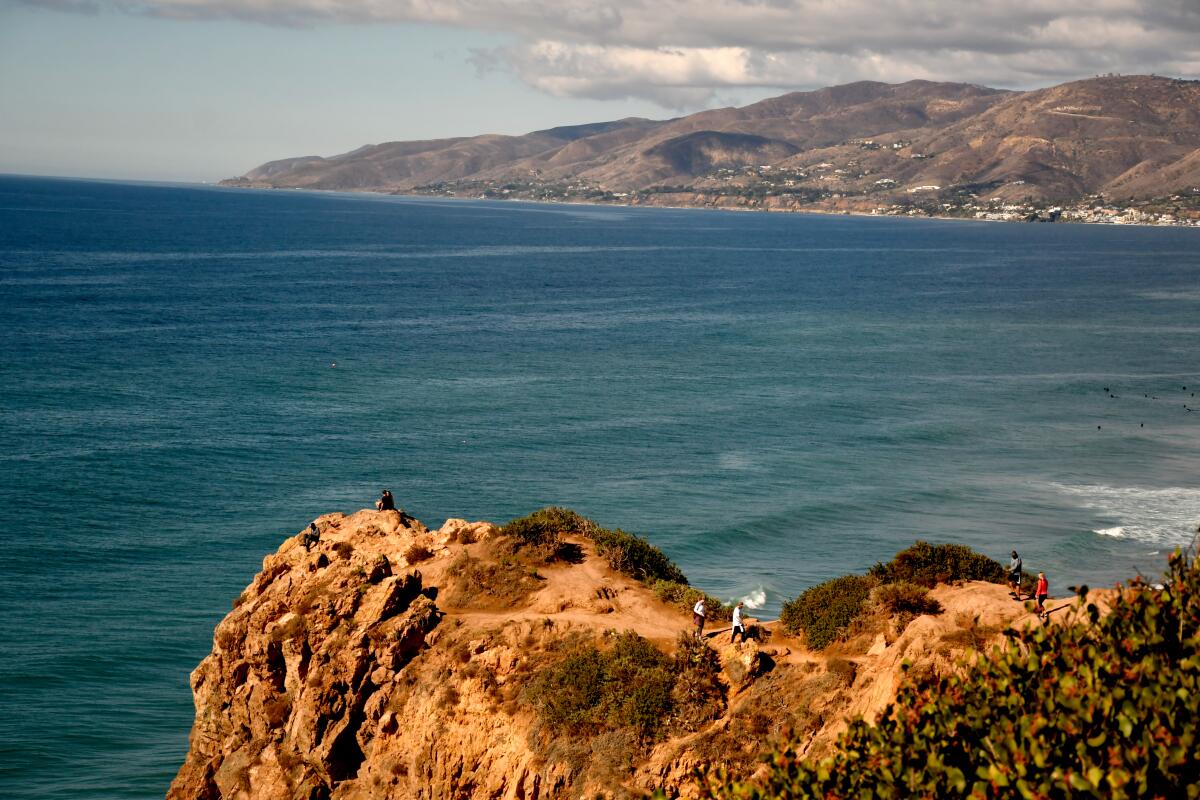
(Christopher Reynolds / Los Angeles Times)
Point Dume and Zuma Beach are names possibly garbled from back in time. In 1793, the British explorer George Vancouver found a generous welcome at the San Buenaventura mission, in the persons of the Franciscan padres Vicente Santa Maria and Francisco Dumetz, whom he referred to as “Vincente” and “Dume” in his account of the journey.
There being no Venmo equivalent at the time, Vancouver thanked his hosts by naming the point of land after Dumetz. (He named a San Pedro promontory Point Vicente after the other missionary). An 1870 plat map for Rancho Topanga Malibu Sequit, in the Huntington Library archives, shows the spot as “Point Zuma or Duma.”
There being no Venmo equivalent at the time, Vancouver thanked his hosts by naming the point of land after Dumetz. (He named a San Pedro promontory Point Vicente after the other missionary). An 1870 plat map for Rancho Topanga Malibu Sequit, in the Huntington Library archives, shows the spot as “Point Zuma or Duma.”
Show more Show less
Route Details
Nicholas Canyon Beach
Malibu Beach
Nicholas beach is up the road from Zuma/Duma/Zume, and a place-name of almost as long a memory, per a county lifeguard service history. It bears the name of an 1840s bandit who made a living holding up passing locals and hiding out in the canyon. When a Mexican government posse cornered him, he jumped from a cliff there and died.
Show more Show less
Route Details
Will Rogers State Beach
Pacific Palisades Beach
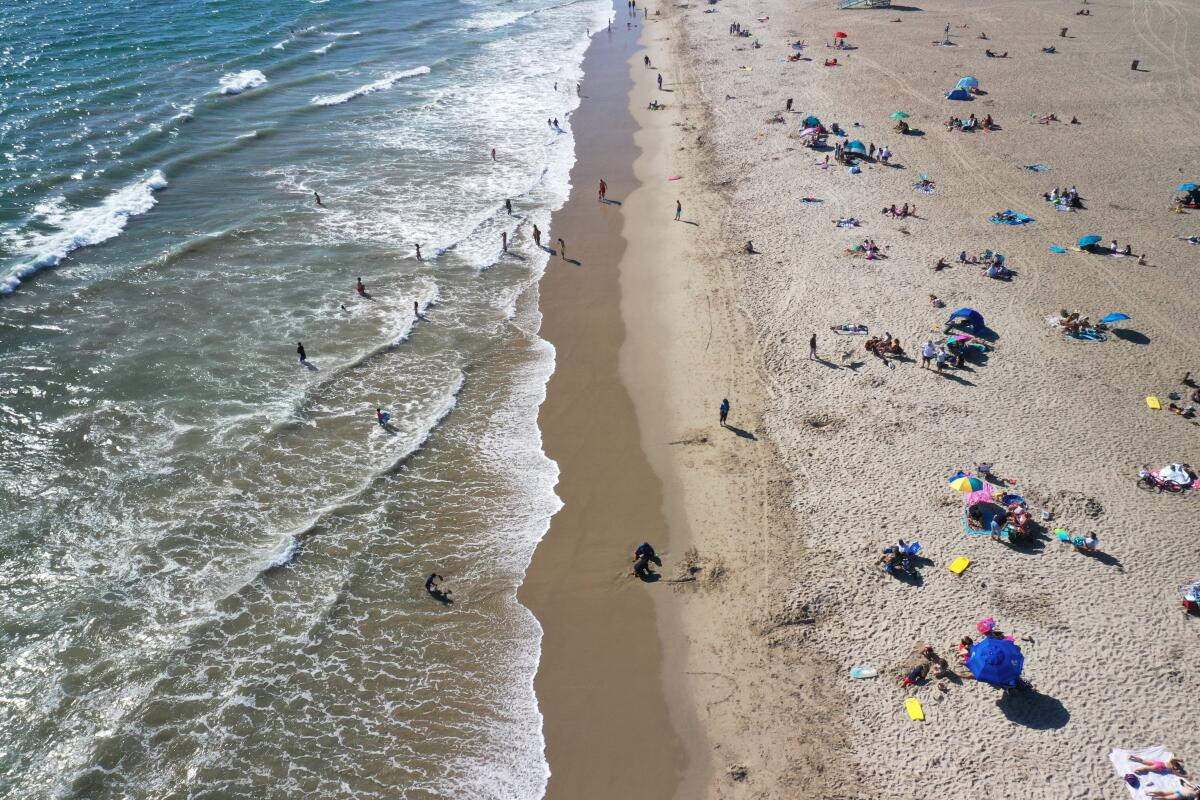
(Carolyn Cole / Los Angeles Times)
Will Rogers, the down-home Oklahoma humorist and actor, whose popularity and paychecks were enormous, held the title of honorary mayor of Beverly Hills. But it was the hundreds of acres he bought along Santa Monica Bay, in Pacific Palisades, that became a state park, a gift from his family after his death in a plane crash, and a state beach run by L.A. County.
Show more Show less
Route Details
Leo Carrillo State Beach
Malibu Beach
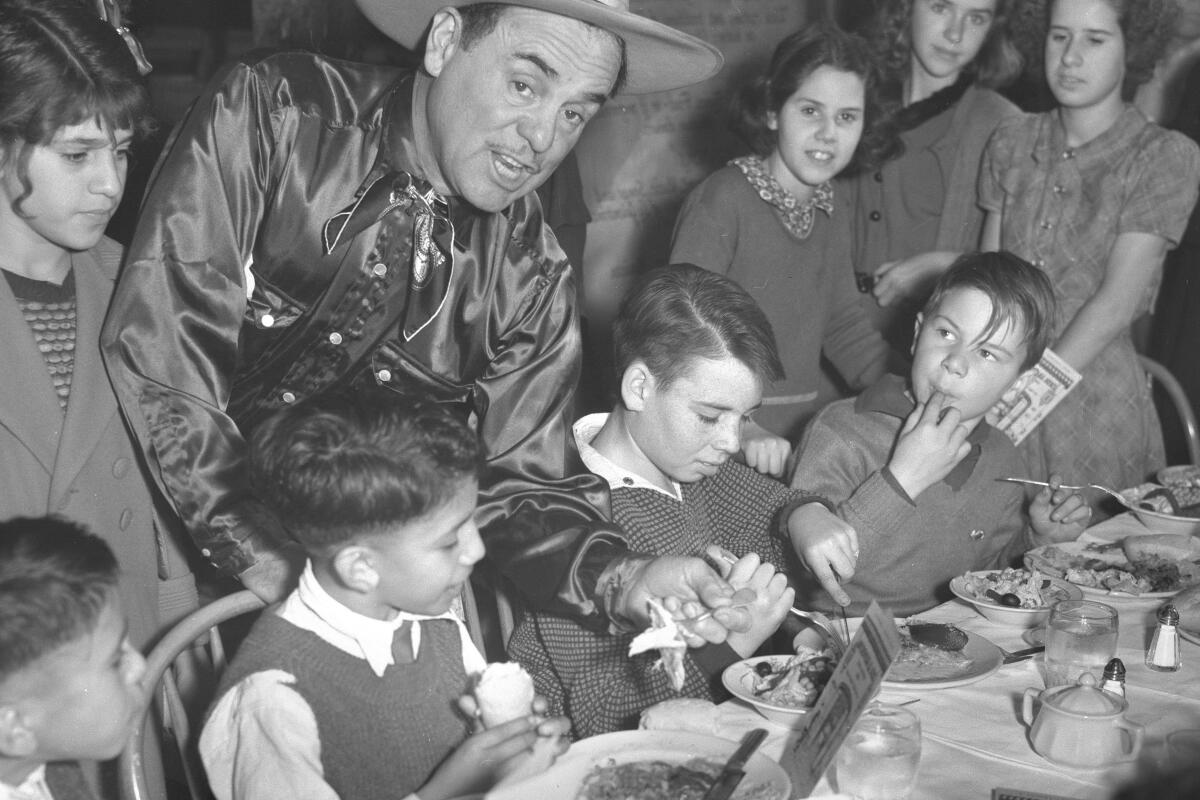
Actor Leo Carrillo hosts Thanksgiving dinner for children in 1937.
(Los Angeles Times)
Leo Carrillo was an actor and a descendant of the renowned family that is among the founders of Spanish Southern California. He was also a committed conservationist who served on the state beach and parks commission for nearly 20 years. He was instrumental in the state laying hold of the Anza-Borrego Desert State Park, and Hearst Castle. Gov. Pat Brown once called him “Mr. California.”
Show more Show less
Route Details
Dockweiler State Beach
Playa del Rey Beach
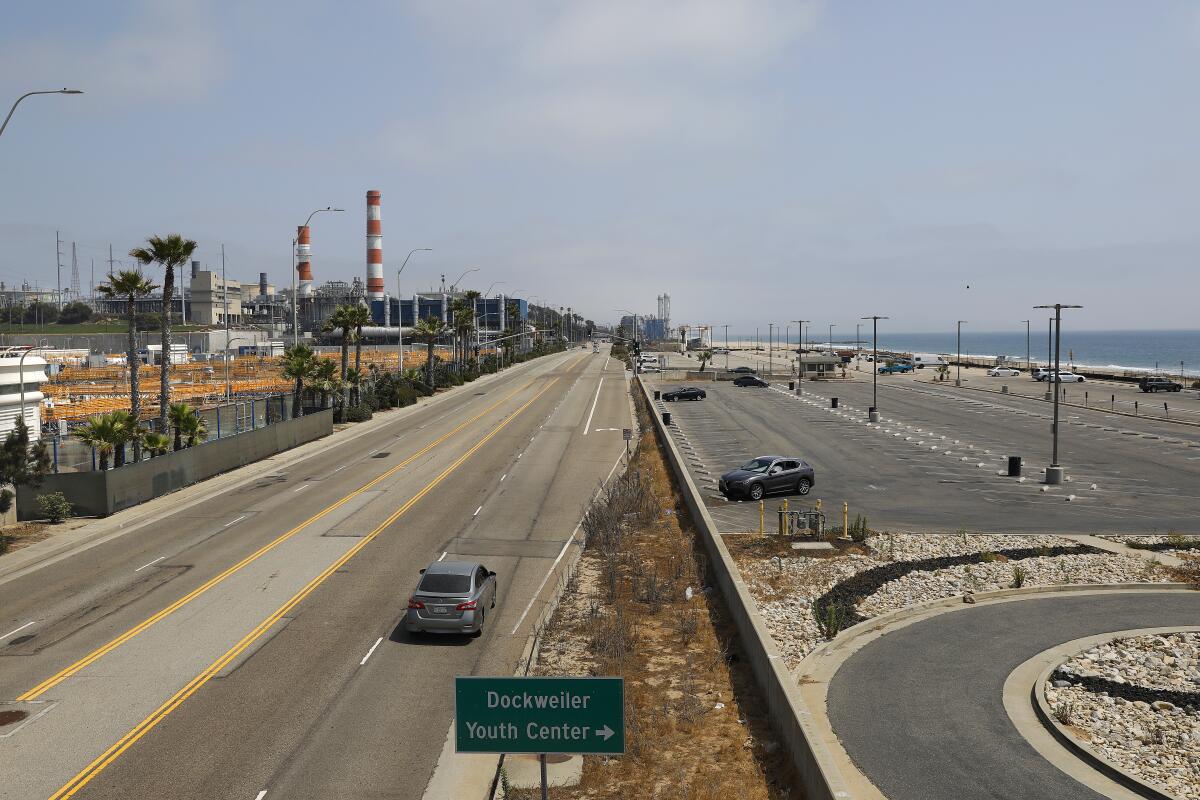
(Christina House / Los Angeles Times)
Isidore Dockweiler was a Los Angeles native, born in 1867 at First and Broadway in downtown L.A., a leading lawyer and Democratic politician and confidant of President Woodrow Wilson. He sat on the state park commission, which named the beach for him after he died.
Route Details
Robert H. Meyer Memorial State Beach
Malibu Beach
The Robert H. Meyer Memorial State Beach is really three cliff-and-cove pocket packs — El Matador, El Pescador, and La Piedra, the bullfighter (or killer), the fisherman, and the rock. Meyer was one of that breed of vigorously effective civil servants, a popular deputy director of the state’s parks and recreation department who helped the state to acquire lands and estates that might otherwise have been built up or even paved over.
Show more Show less
Route Details
Haggerty's beach
Palos Verdes Estates Beach
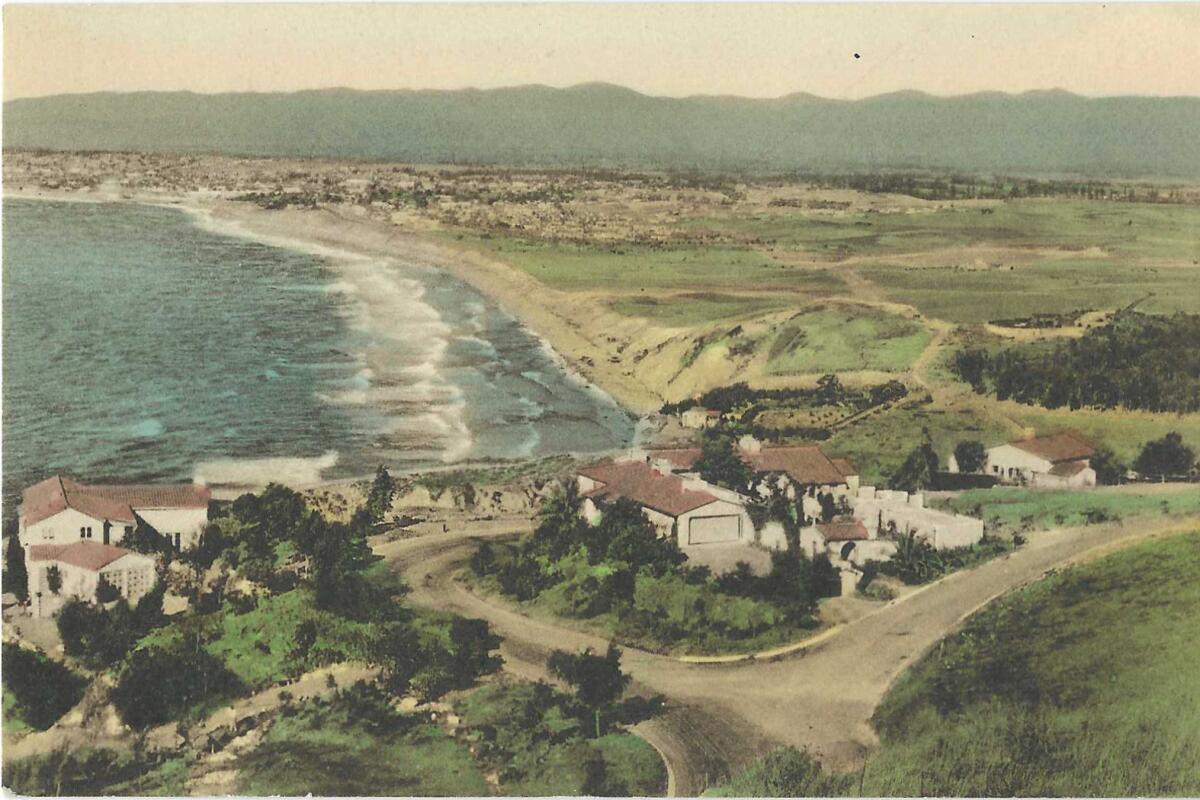
(Postcard from Patt Morrison’s collection)
J.J. Haggarty was an English-born merchant who opened his clothing store in downtown L.A. in about 1905. The business prospered to a dozen stores, and closed in 1970. In the late 1920s, Haggarty built a 32-room summer villa on the peninsula. A church group bought the place in 1950 and has been holding services on the site ever since, but as far as the Beach Boys and locals are concerned, it remained, misspelling and all, Haggerty’s.
Show more Show less
Route Details
Bruce's Beach
Manhattan Beach Beach
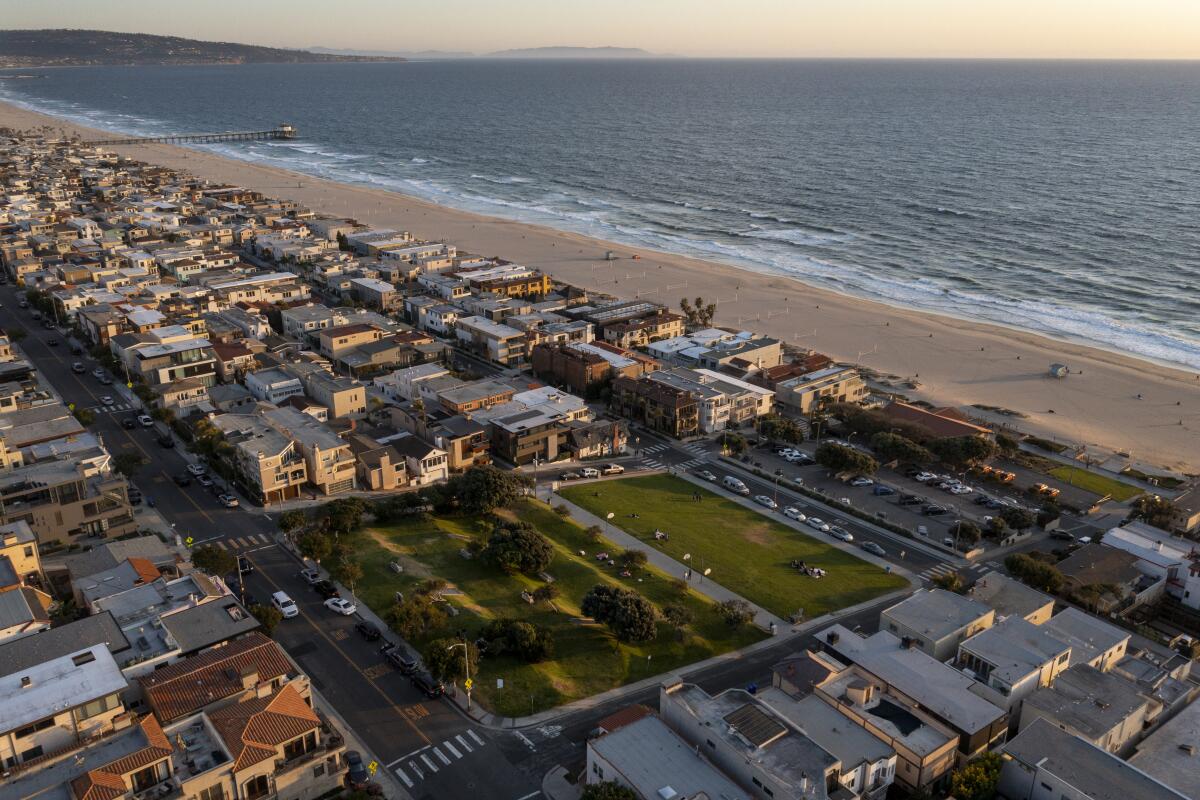
(Allen J. Schaben / Los Angeles Times)
One bit of history was brought back to life last year when Gov. Gavin Newsom signed a law undoing a nearly 100-year-old-wrong. Bruce’s Beach, in Manhattan Beach, is being returned to the descendants of the Black entrepreneurs who owned the land and ran a resort there. They were threatened and harassed, their property torched. The city raised up barriers that forced Black people to walk a long, indirect route to get there. When that didn’t dislodge the resort owners, their property and several others belonging to both white and Black residents was taken by eminent domain for a park that was never built.
Show more Show less
Route Details
Rosie's Dog Beach
Long Beach Beach

(Mel Melcon / Los Angeles Times)
In Long Beach, the county’s only off-leash dog park has a canine namesake. About 10 years after its 2001 opening, it was renamed for Rosie, an English bulldog whose family petitioned for the name change. Rosie’s Facebook page says that she “loved rides in her red flyer wagon and spending lazy days napping on her chair in the living room.”
Show more Show less
Route Details
Mt. Baldy
Mountain
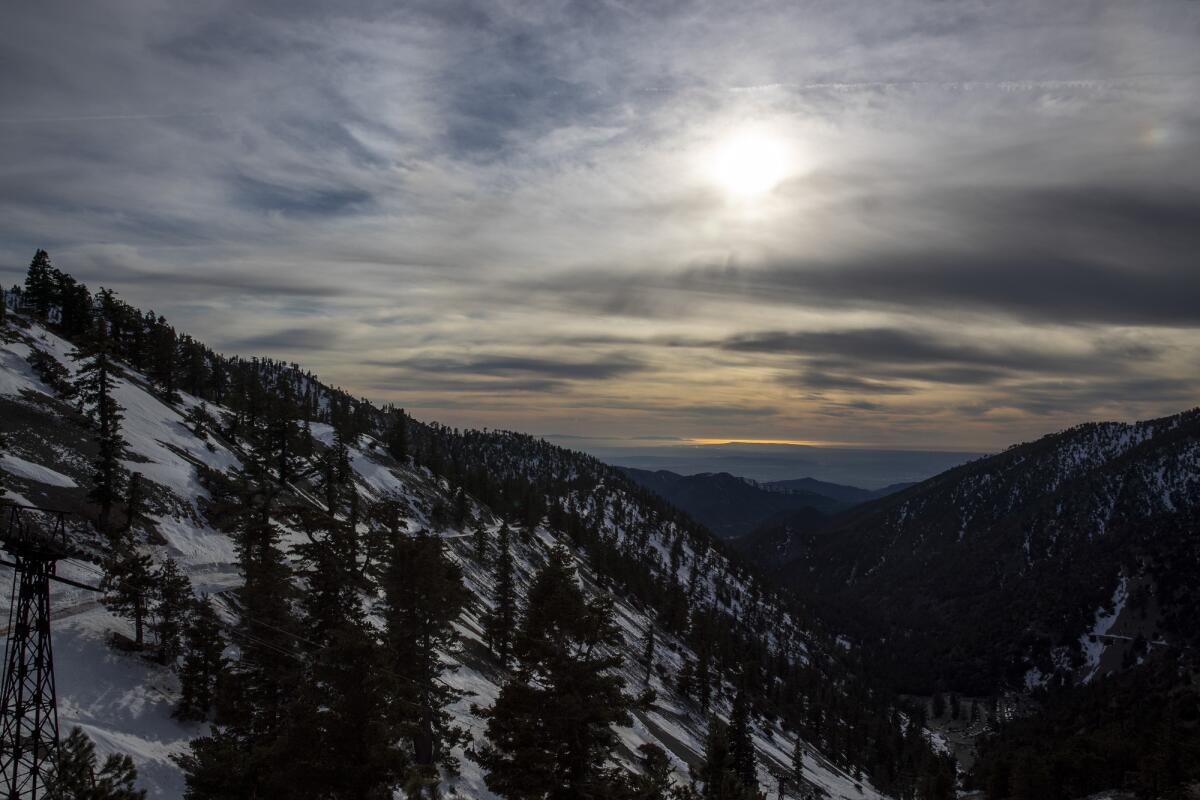
(Brian van der Brug/Los Angeles Times)
Mt. San Antonio, the tippy-topmost peak in the San Gabriels, might be the only mountain that registers on your retinas from pretty much anywhere around Los Angeles. But you wouldn’t be calling it by that name. You know it as Mt. Baldy. But the official federal list of geographical features strictly uses Mt. San Antonio. St. Anthony of Padua, San Antonio, was a Franciscan, as were most of the padres of the series of California missions, so that’s where you’ll find the smart money for the origins of the mountain’s name. “Baldy” signifies the bare expanses of rock on the face of the summit.
Show more Show less
Route Details
Mt. Lee
Hollywood Mountain
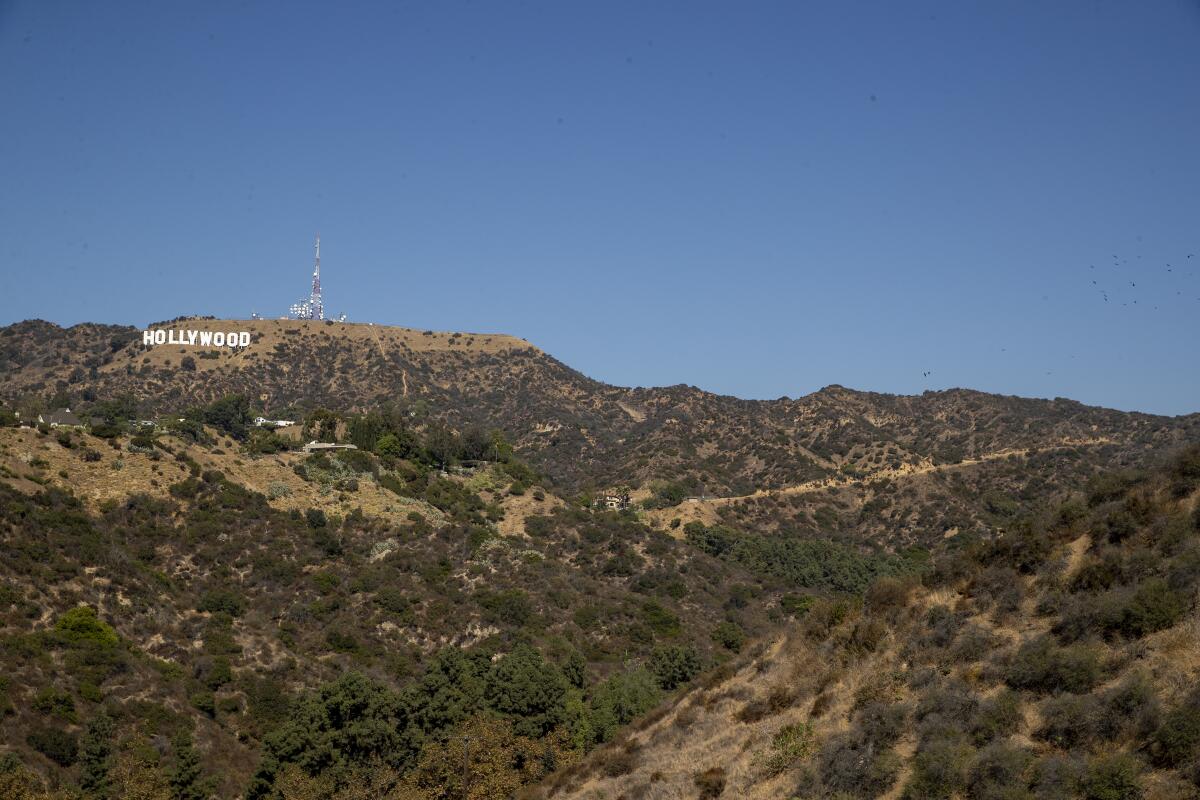
(Brian van der Brug / Los Angeles Times)
You’d think the Hollywood sign would logically be found on the slopes of Mt. Hollywood, but no. The Hollywood sign is on Mt. Lee, named for Don Lee, who rose from running a bike shop on Main Street in downtown L.A. to making a tidy sum selling Cadillac LaSalles. He then turned to broadcast — first a radio network then a venture in TV. His transmitters stood atop the urban mountain that carries both his name and the Hollywood sign.
Show more Show less
Route Details
Mt. Lowe
Mountain

(Myung J. Chun / Los Angeles Times)
In a land of promoters and dreamers, Thaddeus Lowe was a standout visionary, a scientific autodidact who came to California more than 20 years after his service as creator and chief aeronaut of the Union Army balloon corps. He wanted to give paying customers the same rush that high-flying balloons gave him. His thrill ride was a three-stage, seven-mile trip from Altadena to the summit of Echo Mountain in the San Gabriels.
It opened in 1893. For a $5 fare, passengers took an increasingly daunting trolley ride up from Altadena, transferred to a cable car, then back to a small trolley car, taking so many hairpin turns to the mountaintop that even now, just looking at hundred-year-old postcards of it makes me queasy — Toonerville trolleys edging around a supposed 127 curves in 3½ miles. If visitors’ hearts were still beating, they could enjoy their destination: a mountaintop resort of hotel, tavern, riding trails, dance hall and vistas to the sea.
The aerial railway carried its last rider in 1937. By then, buildings had burned down or slid away off the mountain, and in March 1938, the epochal rainfall that disastrously flooded the L.A. River many miles downhill also washed away Lowe’s great enterprise.
It opened in 1893. For a $5 fare, passengers took an increasingly daunting trolley ride up from Altadena, transferred to a cable car, then back to a small trolley car, taking so many hairpin turns to the mountaintop that even now, just looking at hundred-year-old postcards of it makes me queasy — Toonerville trolleys edging around a supposed 127 curves in 3½ miles. If visitors’ hearts were still beating, they could enjoy their destination: a mountaintop resort of hotel, tavern, riding trails, dance hall and vistas to the sea.
The aerial railway carried its last rider in 1937. By then, buildings had burned down or slid away off the mountain, and in March 1938, the epochal rainfall that disastrously flooded the L.A. River many miles downhill also washed away Lowe’s great enterprise.
Show more Show less
Route Details
Mt. Wilson
Mountain

(Gina Ferazzi / Los Angeles Times)
The “Wilson” of Mt. Wilson is Benjamin Wilson — called “Don Benito,” after the fashion of ambitious Yankees who took on a Spanish name as a business and marital emollient in Mexican Southern California. The mountain took his name some time after Wilson, in 1864, cleared a trail up its flank to clear timber for his myriad business interests. Over the course of his years here, he ranched, sold and bought land, politicked (as L.A. mayor, county supervisor and state senator), and wrote a study of contemporary local Native Americans.
You may not have heard of him, but you’ve surely heard of his grandson, who spent some of his free time in the family’s San Marino home: Gen. George S. Patton.
You may not have heard of him, but you’ve surely heard of his grandson, who spent some of his free time in the family’s San Marino home: Gen. George S. Patton.
Show more Show less
Route Details
Waterman Mountain
Angeles Crest Mountain
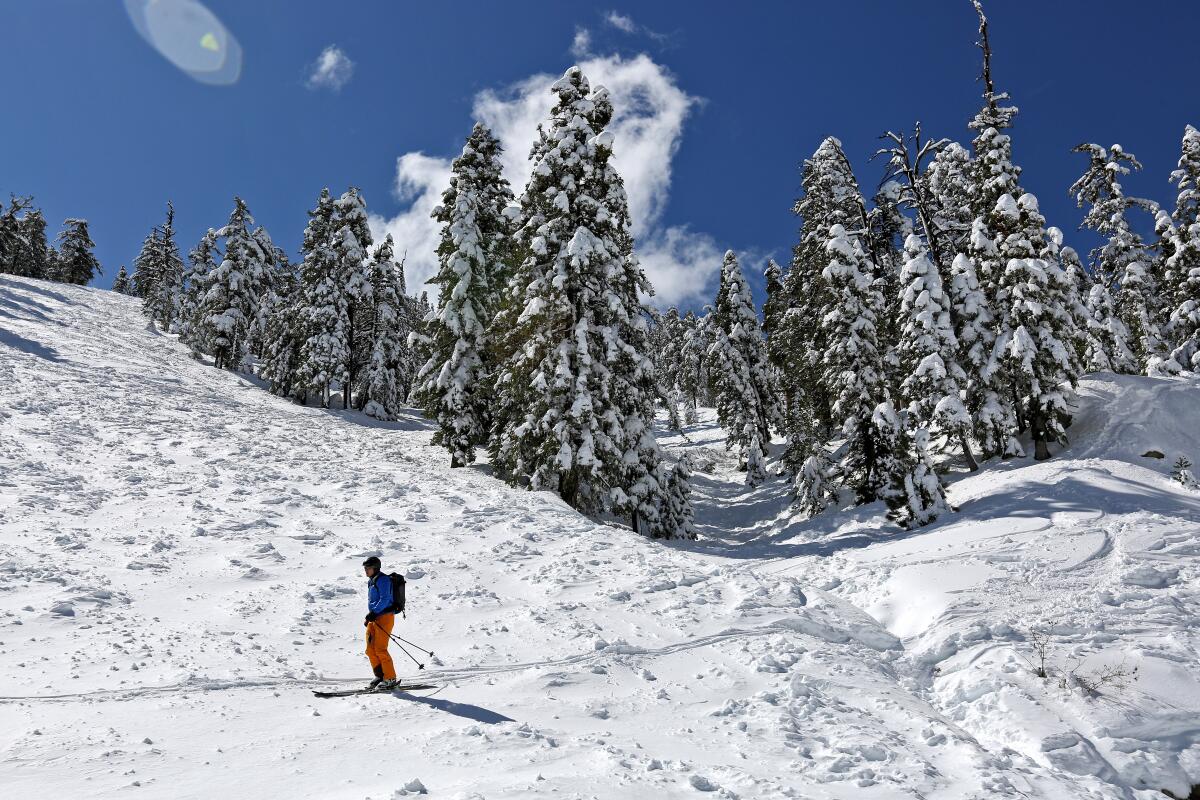
(Raul Roa / Los Angeles Times)
In the spring of 1889 an ardent forester and outdoorsman named Robert B. Waterman, his wife, Liz, a California native, and a friend who went by the splendid name of Commodore Perry Switzer (as in the future Switzer Falls, a beauty spot in the San Gabriels), spent about three weeks going there and back over the mountains from La Canada into the Antelope Valley, climbing right along with the bighorn sheep.
Because Frau Waterman was evidently the first non-native woman to scale those heights, her husband decided that the peak should bear her name. He didn’t name it Liz, or Elizabeth, but “Lady Waterman’s Peak.” They even built a monument of rocks at the summit to mark the event. Well, as the official U.S. Geological Survey maps got drawn, somehow, somewhy, the “Lady” part disappeared from the map.
Because Frau Waterman was evidently the first non-native woman to scale those heights, her husband decided that the peak should bear her name. He didn’t name it Liz, or Elizabeth, but “Lady Waterman’s Peak.” They even built a monument of rocks at the summit to mark the event. Well, as the official U.S. Geological Survey maps got drawn, somehow, somewhy, the “Lady” part disappeared from the map.
Show more Show less
Route Details
Mt. Lukens
Tujunga Mountain
Mt. Lukens is nearly a mile high, the tallest peak within L.A. city limits.
Theodore Parker Lukens gave up his post as president of a Pasadena bank to take up the work of conservation and reforestation in the burned-over mountains and canyons of the San Gabriels in the early 1900s. His half-dozen years working with the federal government created a template for replanting and restoration programs. We’re talking tens of thousands of, maybe even a hundred thousand, trees. Lukens started a tree nursery at Henninger Flats, experimenting with species that could withstand heat, drought and fire.
Theodore Parker Lukens gave up his post as president of a Pasadena bank to take up the work of conservation and reforestation in the burned-over mountains and canyons of the San Gabriels in the early 1900s. His half-dozen years working with the federal government created a template for replanting and restoration programs. We’re talking tens of thousands of, maybe even a hundred thousand, trees. Lukens started a tree nursery at Henninger Flats, experimenting with species that could withstand heat, drought and fire.
Show more Show less
Route Details
Mt. San Jacinto
Mountain

(Allen J. Schaben / Los Angeles Times)
“Jacinto” translates to “hyacinth.” St. Hyacinth is beloved in Poland, and is the patron saint of Lithuania. Hyacinth was a well-educated and well-traveled 13th century Polish priest who is, among other credits, the patron saint of weightlifters.
Route Details
Mt. San Gorgonio
Mountain
Who was the saint in San Gorgonio? There were several martyred Gorgoniuses in the Catholic lists; the likeliest candidate for ours is St. Gorgonius of Nicomedia. He worked for the Roman emperor Diocletian, and he more or less outed himself as a Christian when he protested the torture of another Christian on the household staff. In consequence, he shared that man’s fate — flayed, trampled, burned at the stake, grilled on a gridiron.
Show more Show less
Route Details
No matching entries.
Please reset filters to see all entries.
No matching entries.
Please reset filters to see all entries.
Top
